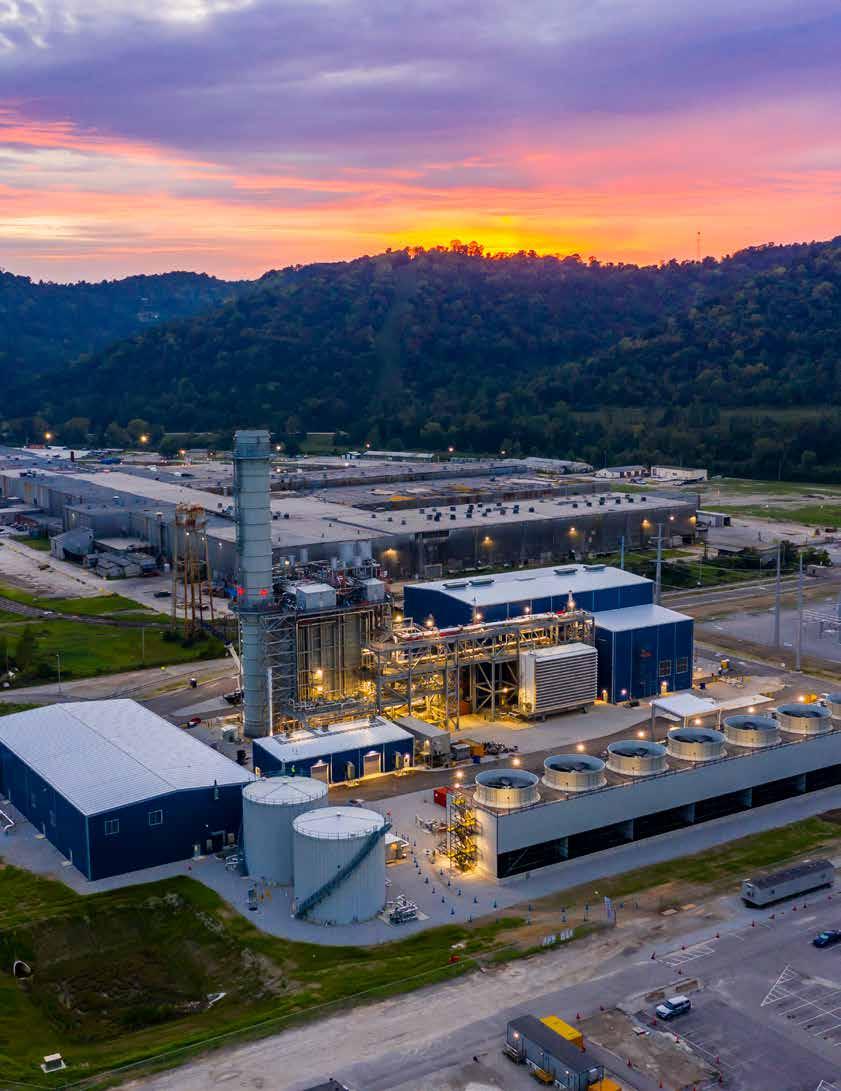

ENERGY MARKET UPDATE

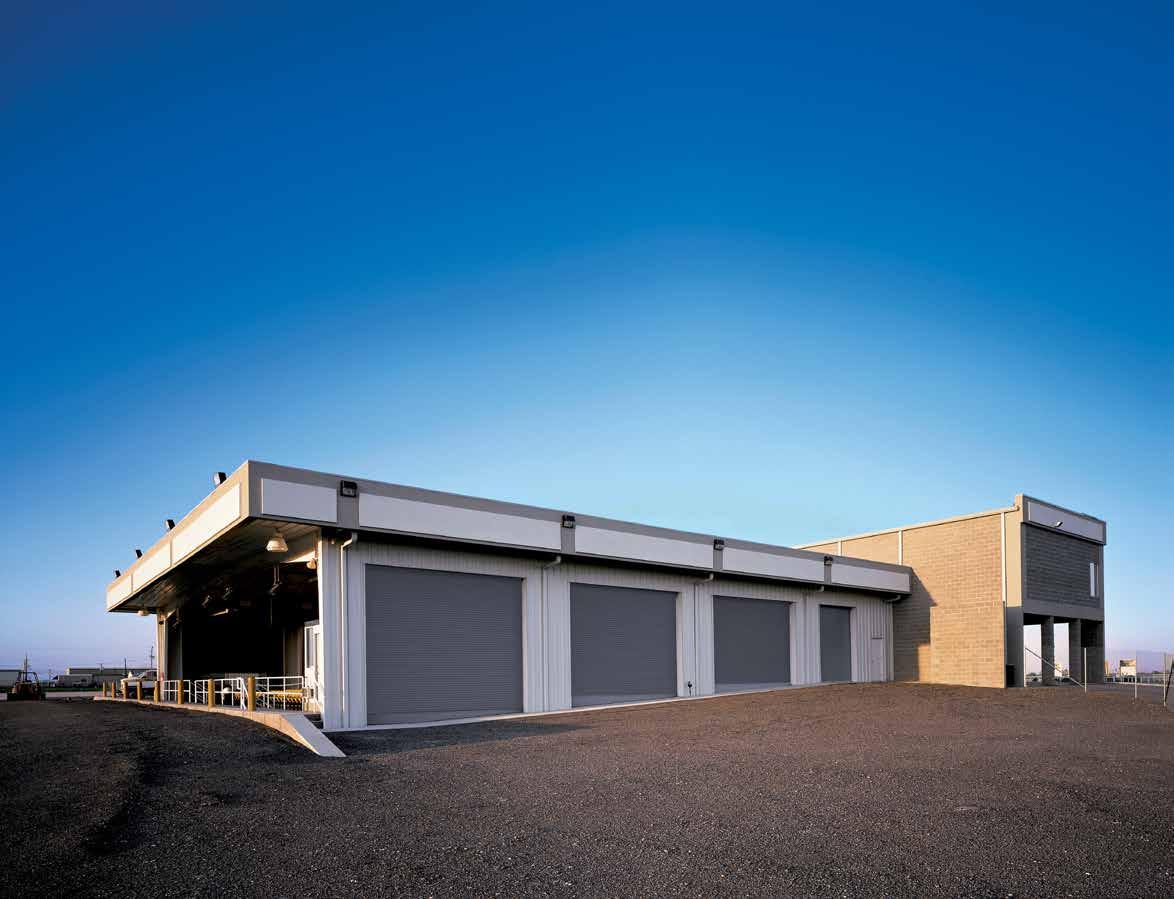
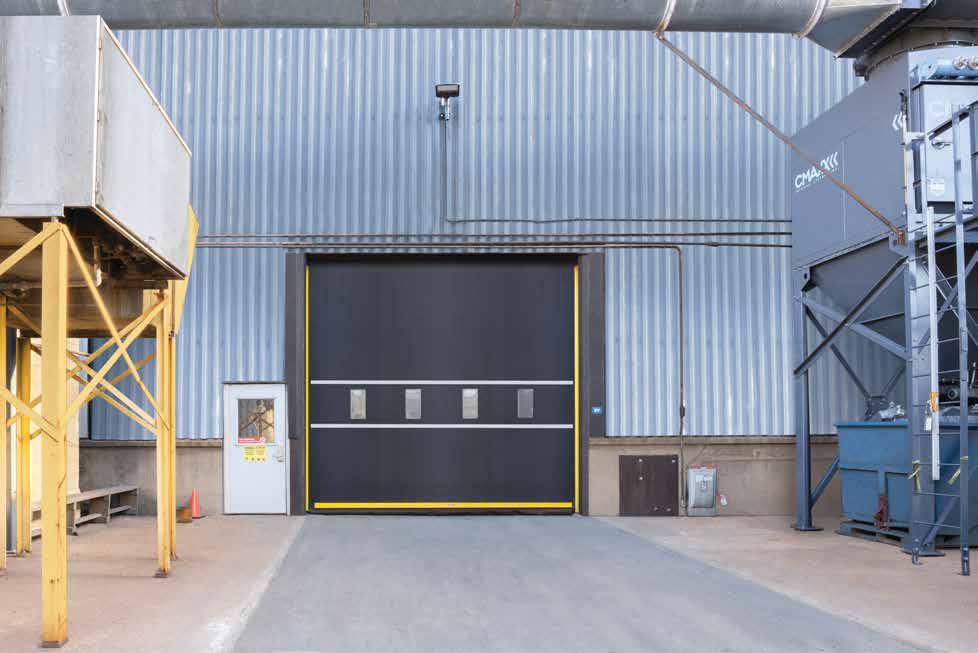
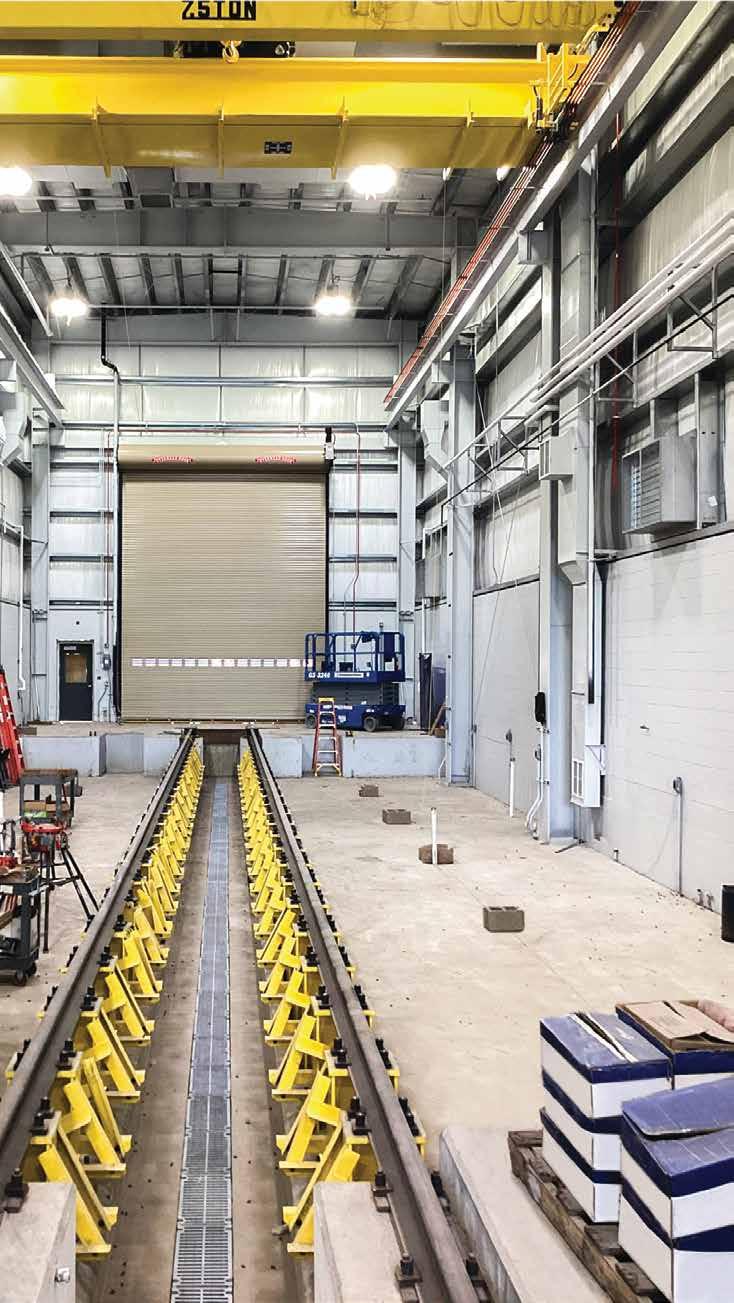






PUBLISHER
Master Builders’ Association of Western PA www.mbawpa org
EDITOR
Jeff Burd 412-366-1857 jburd@talltimbergroup.com
PRODUCTION
Carson Publishing, Inc.
Kevin J. Gordon
ART DIRECTOR
Carson Publishing, Inc.
GRAPHIC DESIGN
CONTRIBUTING PHOTOGRAPHY
Clint Davis Dobresum FlyPittsburgh
Gerville Photography
Chad Isaiah Studios
Jordan King
Master Builders’ Association of Western PA Massaro Corporation
Kaitlin Brinser, Mediaquest
NAIOP Pittsburgh Tall Timber Group
SPONSORSHIP DIRECTOR
Mary Chuderewicz mchuderewicz@mbawpa org
MORE INFORMATION:
BreakingGroundTM is published by the Master Builders’ Association of Western Pennsylvania, 412-922-3912 or www.mbawpa.org
Archive copies of BreakingGroundTM can be viewed at www.mbawpa.org
No part of this magazine may be reproduced without written permission by the Publisher. All rights reserved.
This information is carefully gathered and compiled in such a manner as to ensure maximum accuracy. We cannot, and do not, guarantee either the correctness of all information furnished nor the complete absence of errors and omissions. Hence, responsibility for same neither can be, nor is, assumed.
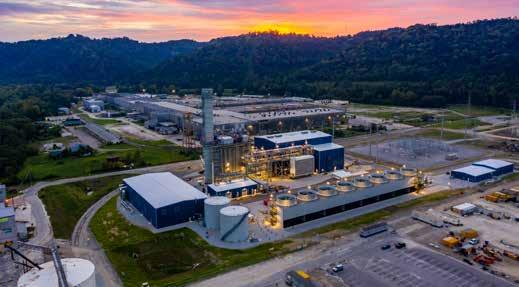
Correction:
Capitalize on Electrification: Trends in the
On the cover: Long Ridge Energy Hannibal Terminal. Photo by Clint Davis.














PUBLISHER’S NOTE
We are sleepwalking towards another energy crisis. Those of you who were born after 1980 won’t recall the pain of the multiple shocks that OPEC threw at the United States in the 1970s. Prices of heating fuel and gasoline doubled and then doubled again. Gas was rationed. Lines at gas stations stretched for blocks. Those experiences toppled a couple of presidents and led to a series of policies that aimed to eliminate American dependence on foreign energy sources.
Alas, we’re Americans. We forget. We also like to fight. Over the past decade we have become increasingly more polarized and willing to fight over insignificant differences. That has had the net effect of reducing all our differences to a similar level of insignificance. And of course, not all our problems are insignificant. I would certainly not put the problem of insufficient power in the insignificant category.
I’ve spent most of the last two months researching the energy markets and talking to smart people about our looming energy crisis. Unlike 50 years ago, our current situation is not a surprise or the result of some outside actor. It has been obvious for more than a decade that we have been consuming electricity at a rate that was going to outpace the growth in supply. Ten years ago, it appeared that it would happen by 2040. Two years ago, it appeared we’d hit that wall in 2030. Now PJM Interconnect, the agency responsible for managing our electric grid, tells us that we will not have enough power to keep up with demand by next year.
Where all this gets maddening is that we have more than enough resources to deal with the problem. What we lack is coherent and courageous leadership.
Government and civic leadership have been wisely moving society towards a cleaner and safer climate in this century. In doing so, however, they have made policy choices that have left us in a tight spot. Both locally and statewide, we have been led towards renewable energy without a game plan for fully replacing the fossil fuels we were leaving behind. It may have taken the boom in AI data centers to sound the alarm, but it has been apparent (and well communicated) that we were heading towards using more energy than we produced. For many years we have tried to have our cake and eat it too. Leaders in Western PA hailed both the job creation of renewable energy and of the shale gas play at the same time, without considering (or communicating) the problems caused by promoting both. Using gas to replace coal for electricity generation gave us a cheap – and quick – way to improve the environment and power supply. Of course, burning natural gas still pollutes the atmosphere. Would it have been a better strategy to use natural gas as a stepping
stone from coal to something renewable? Would that have given the manufacturers of solar panels and batteries the time necessary to overcome the intermittency, reliability, and capacity problems inherent in the technologies when we had ample energy supply?
You’ll probably not be surprised to learn that the solutions to the energy problems will be more difficult to implement in Pennsylvania. Policy decisions, seemingly made with good intentions over time, have made fixing the problem more complicated here. Many states have authorities that oversee the review process for locating a power plant, superseding the authority of a county or municipality for the common good. Not PA. Within PJM’s regional grid, PA is unique in separating the generation of electricity from the distribution. In Ohio or Virginia, where dozens of massive data centers are being built, the power company can respond to the new demand. Not in PA. I’m sure there are plenty of problems you can blame Duquesne Light for causing but finding you more power is not one of them.
Our governor seems to understand the problem. His state has the resources to generate more electricity, and he seems to have nudged the grid manager towards being more responsive after picking a fight with them. But, when it comes to solutions, Gov. Shapiro is almost certainly going to have to make compromises. For now, Republicans favor using our fossil fuel resources to generate more power quickly. So do many of the reliably Democratic voters in Western PA. The governor and the legislature are going to have to make choices that make some people mad. If they don’t, we are likely to get a bad solution.
Strong leaders are willing to make choices that make some people, even people who support them, mad. That doesn’t mean the leader can’t talk about the solution with the people who will be mad. Doing so might even help find a better long-term solution that doesn’t make people mad.
We find ourselves in a position where time is not a luxury we have. If, as predicted, electricity demand exceeds supply in the next few years, we’ll have power outages in PA. When that happens, the lights will go out for those who favor solar panels and gas-fired power plants. It won’t be “them,” the bad guys, who will lose power. It will be all of us.
LABOR & BUSINESS
Allies for Economic Growth

REGIONAL MARKET UPDATE
BY JEFF BURD AND BEN ATWOOD
By all accounts, 2025 opened with tepid bidding activity. Activity ticked up in February, with universities and hospitals lining up smaller construction projects, and several major public projects advancing to the market. Thus far, competition on public projects has been strong enough that most projects are coming within budget expectations.
Preconstruction and bidding moved forward on the larger private sector construction projects for 2025. Rycon Construction advanced bid packages on the $150 million Allegheny Health Network (AHN) South Hospital, which will replace Canonsburg General Hospital in North Strabane Township. PJ Dick is working on getting the 159-unit Caroline at University Commons Apartments being developed by Walnut Capital on McKee Place and the $120 million Gulf Tower conversion. Mascaro Construction held subcontractor and vendor information meetings for the $390 million first phase of the Esplanade development that Piatt Companies is proposing for the North Side.
Aside from the AHN Canonsburg project, 2025 is likely to be the first year in more than a decade that a major hospital or higher education project does not get underway.
Uncertainty about the long-term enrollment picture remains a drag on capital spending for colleges and universities. Those difficult conditions have been acerbated by threatened funding cuts for health and technology research. Pittsburgh has been fortunate to be home to two major
institutions, Pitt and Carnegie Mellon, that have largely avoided enrollment decline and have hundreds of millions in construction planned for the balance of the decade. A third university, Duquesne University, has adapted quickly to market conditions and continues to update and add to facilities. Duquesne announced in mid-February that it had exceeded its $335 million fundraising goal, which was slated to cover more than $75 million in construction projects. However, if the level of federal grants does fall to the levels threatened as the Trump administration began, capital investment will suffer.
Healthcare has a better outlook for demand for services but is suffering from a series of business-related problems. Costs for delivering healthcare increased rapidly following the pandemic, particularly costs associated with staffing. Hospitals continue to experience a shortage of nurses and doctors. Like with higher education, healthcare is feeling greater uncertainty since the change in administration. Grant cuts impact healthcare as well as education, and the Republican-controlled Congress is again making threats to upend the Affordable Care Act. The latter could leave hospitals uncertain about reimbursements for services, particularly if any healthcare insurance reform included Medicaid and Medicare.
Even without high levels of activity in higher education and healthcare, construction volume should be as strong in 2025 as it was in 2024. Philanthropic support for non-profit institutions is strong and there are multi-million capital plans moving forward at the Carnegie Libraries and Pittsburgh Zoo, along with numerous other non-profit organizations. The prospects for manufacturing are better than most years, including the improved likelihood of a billion-dollar investment at the Edgar Thompson Works and of one or more major data center sites being approved for development. Currently, data center developers are looking at five sites in Armstrong, Allegheny, Beaver, and Westmoreland counties.
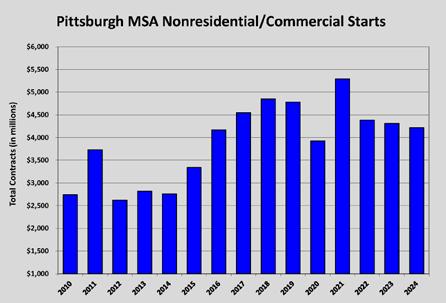
Activity in nonresidential/commercial construction was virtually the same in 2024 as it was in 2023. Given the similarity in conditions between the two years, that is not a surprise. While it was hoped that there would be noticeable relief from higher interest rates in the latter half of 2024, an outcome that did not materialize, most of the other factors boosting or limiting the market sectors in Pittsburgh remained
Nonresidential/commercial construction activity fell slightly from 2023 to 2024. Source: Tall Timber Group.
unchanged. Healthcare and higher education continue to face uncertain futures. Housing demand well outstrips the ability to deliver sufficient multi-family supply. Office utilization lags pre-pandemic levels, giving tenants leverage in lease negotiations, sparking an increase in tenant improvement construction. Public construction was boosted by federal spending but dragged down by state and local fiscal woes.
For the full year, construction starts totaled $4.2 billion, including construction put in place at the $1 billion UPMC
Heart and Transplant Hospital in Oakland. That was $180 million shy of the 2023 total.
Pittsburgh’s housing market jumped 36.8 percent year-overyear in 2024, driven by a 113.4 percent increase in multi-family starts, according to the Pittsburgh Homebuilding Report. Permits were issued for 2,085 single-family-detached homes, an increase of 170 homes, or 8.9 percent. That increase was offset by a 14.4 percent decline in construction of townhouses and other attached homes. The latter appears to be the result of a temporary dip in lot supply, but there is concern that the decline reflects a growing trend of rejection of higher-density development in suburban municipalities. Attached homes are currently the best response to the demand from the two largest demographic groups, empty nesters and younger first-time buyers. Townhomes are frequently a lower-cost home ownership option. Limiting the supply of townhouse lots would acerbate the affordability problem.




Multi-family demand remained elevated in 2024 because of the tight inventory of homes for sale and the affordability problem. After two years of significantly lower construction activity, multi-family development surged last year. Developers started 2,892 units of multi-family in 2024, more than doubling the 1,355 units started a year earlier. More than 6,000 units of multi-family are in the pipeline – most of them entitled – which bodes well for another year of 2,000 units or more in new construction.
The spike in apartment construction is more remarkable given the challenging environment for new development. In late January, Tall Timber Group surveyed general contractors and developers that have been the most active in multi-family construction since 2019. In aggregate, these firms have been responsible for starting, or have in the 2025 backlog, nearly 10,000 units in the metropolitan Pittsburgh area since 2019. Firms were asked to provide actual cost data on projects started in 2019 to those either started in 2024 or bidding now. The median response was an increase in construction costs of 36.4 percent.
Given the range of factors that can make significant differences in the overall cost –mid-rise on a podium versus garden-style walk-up, urban versus suburban, with or without structured parking, etc. – the variance in cost increases was relatively minor. Most comparable projects increased in cost by between 32 percent and 38 percent more. The smallest comparable increase was 28.6 percent. The most interesting was a project
priced in 2019 that was shelved because of the pandemic and revived and re-bid in January. The difference in the bids was 46.7 percent.
With construction loans at least 200 basis points higher than in 2019, multi-family owners and developers are investing 50 percent more in 2025 to build the same product. While rents have also spiked – numerous rent-tracking services put Pittsburgh’s median rent more than 35 percent higher than in 2019 – they have not kept up with costs.
Against that backdrop, the Pittsburgh Planning Commission’s decision to approve the expansion of the city’s inclusionary zoning effectively stopped all new multifamily projects that would be affected by the increased affordable unit mandate. Those included several high-profile projects, including the City Club Apartments proposed for Wood Street in Downtown. Aside from reducing construction activity, the slowdown in new development will impact delivery of new housing inventory in 2027-2028.
Lower activity in 2022-2023 means that the number of apartments being delivered in 2025 will be below the long-term average, which will help landlords of desirable properties to raise rents. The new supply coming on board in 2026-2027 will increase competition among Class A properties. While that will stifle rent growth at the upper end of the market, the surge in supply will also put downward pressure on the Class B and Class C properties, which make up the largest share of Pittsburgh’s rental market. That, in turn, will improve affordability.
The office market in Pittsburgh is showing signs of recovery after years of declining demand. While nationwide trends remain uncertain, local leasing activity and absorption figures indicate that Pittsburgh’s office sector may be stabilizing.
Nationally, the office market has struggled throughout 2024, posting 21 million square feet of negative net absorption over the course of the year. However, in a significant shift, the fourth quarter saw 3.3 million square feet of positive absorption—the first positive quarter since 2021. This change suggests that while challenges persist, certain markets may be reaching an inflection point.
Pittsburgh’s office market mirrored this lateyear improvement. The region recorded nearly 500,000 square feet of positive absorption, marking its first quarter of growth since 2019. Even more notably, over 300,000 square feet of space was absorbed for the full
year, the largest annual positive absorption since 2017. This signals renewed leasing momentum, particularly in sectors that require in-person collaboration.
Leasing activity also saw a meaningful shift. The average lease size increased 18 percent year-over-year, reaching 6,000 square feet per deal. Compared to 2022, this represents a 25 percent growth in the average lease footprint. Larger tenants committing to space suggests that businesses may be more confident in long-term office needs, even as hybrid work


models persist.
Despite these positive indicators, it remains too early to declare a full-fledged recovery. Nearly 300,000 square feet of vacant space were put on the market in the Airport Corridor in the first quarter, which will be a drag on the market. New office construction is limited, meaning much of the market’s future performance will depend on how existing space is utilized and whether leasing demand continues to rise.
While industrial vacancies are increasing nationwide, Pittsburgh’s industrial market is tightening due to limited new development. Pittsburgh’s industrial vacancy rate stands at 5.1 percent, a 0.5 percent decline year-over-year. Unlike major shipping hubs, Pittsburgh has historically seen more cautious industrial expansion. This trend continues into 2025, with just 310,000 square feet of construction underway, the majority of which is build-to-suit. The restricted supply should help maintain a balance between supply and demand in the region.
Absorption levels reached 1 million square feet in 2024, a solid indicator of demand. However, leasing volume was 16 percent below the 2015-2019 average, reflecting a broader post-pandemic cooling of warehouse needs. This shift aligns with national trends, where the surge in logistics-driven industrial leasing has moderated.
The opportunity for builders may be in the construction of smaller facilities, given the lack of speculative development. A CoStar data survey indicates that in industrial/flex projects of 50,000 square feet, the vacancy rate is just three percent, pointing to a significant level of pent-up demand. Rent growth in these assets has increased by 1.5 percent, well above the market average, highlighting the strong demand for flexible industrial space.
Demand for most building types is supported by a regional economy that is strong, even if the environment for growth is challenging.
The year-end data on unemployment and payroll growth in metropolitan Pittsburgh was encouraging. Non-farm payroll employment in the seven-county area rose by 23,100 jobs, a 1.9 percent increase over December 2023. Job gains were strongest in the private sector, led by education and healthcare (plus 9,000 jobs), and leisure and hospitality (plus 6,300 jobs). The largest decline was the loss of 500 jobs in
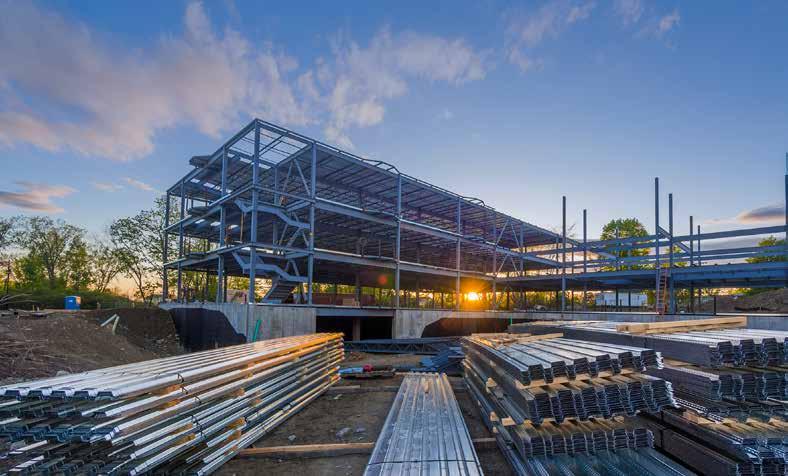
construction, the result of retirement outpacing recruitment rather than shrinking demand for work.
Unemployment ticked up 10 basis points to 3.6 percent, matching the statewide rate and besting the national unemployment rate by one half percentage point.
There was no change to the long-term trend of Pittsburgh’s workforce decline in 2024. The civilian labor force fell by 9,000 workers from December 2023 to December 2024. Unlike the U.S. workforce, which had enough immigration to offset Baby Boomer retirements, the aging out of Pittsburgh’s Boomers continued to run well ahead of any immigration or domestic migration to the region. Without a positive shift in the labor force trend, the demographics of metro Pittsburgh will limit productivity gains. Coupled with a stagnant population, the decline in the workforce makes Pittsburgh less competitive in attracting new business. BG

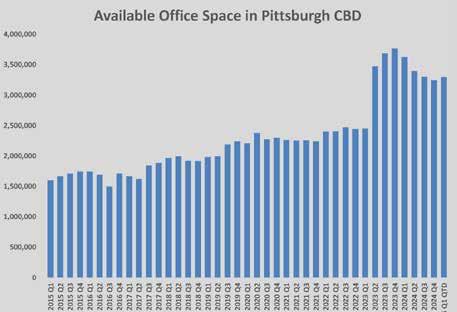
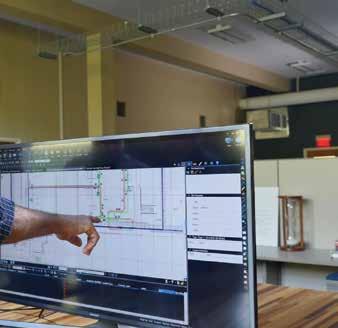

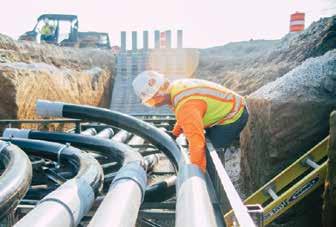
The office space available in Pittsburgh’s central business district declined by more than 500,000 square feet during 2024 but remains more than double the level of a decade ago.
Source: CoStar, Ben Atwood.
BUILDING ABOVE AND BEYOND

Go beyond. Repeat.
Trust your next construction project to PJ Dick.

























































2024 2024 Building Excellence Awards








MASTER BUILDERS’ ASSOCIATION OF WESTERN PENNSYLVANIA,

















www.clistaelectric.com


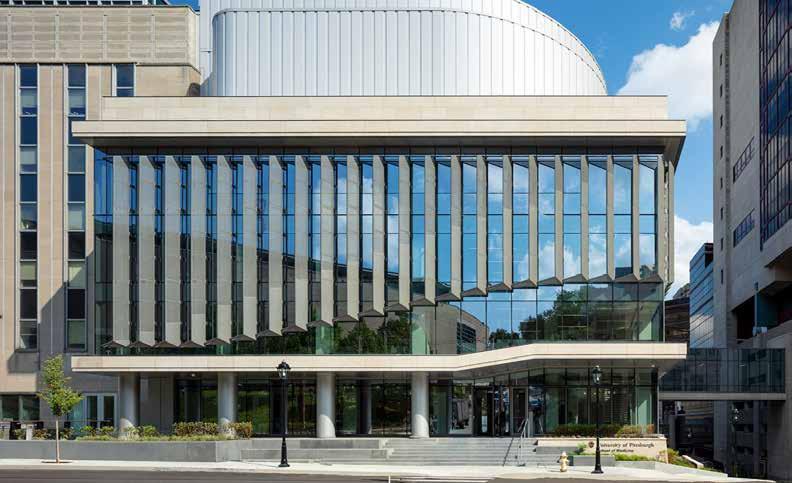


CONTRACTOR:
PJ Dick Inc.
OWNER:
University of Pittsburgh
ARCHITECTS:
Payette, MCF Architecture
MBA SUBCONTRACTORS:
Abate Irwin, Inc.
Ace Lightning Protections, Inc.
Amthor Steel, Inc.
Alliance Drywall Interiors, Inc.
Bristol Environmental, Inc.
Casework Installation Co., LLC
Century Steel Erectors
Clista Electric, Inc.
Cost Company
Costa Contracting, Inc.
D-M Products, Inc.
Flooring Contractors of Pittsburgh
Giffin Interior & Fixture, Inc.
Matcon Diamond, Inc.
Maxim Crane Works, LP
McKamish, Inc.
Mohawk Construction & Supply Inc.
Phoenix Roofing, Inc.
SSM Industries, Inc.
Steel City Scaffolding of Pittsburgh
Swank Construction Co. Inc.
T.D. Patrinos Painting & Contracting Company
W.G. Tomko, Inc.
Wright Commercial Floors
Wyatt Incorporated


Photo













NEW CONSTRUCTION
$20 to $50 Million
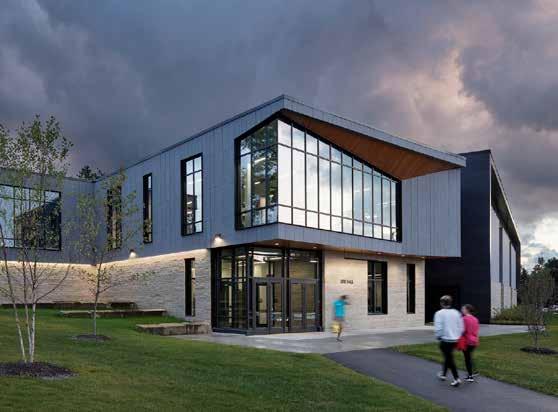

Penn State
Erie Hall Recreation and Wellness Center
CONTRACTOR:
PJ Dick Inc.
OWNER:
Penn State University
ARCHITECTS:
Sasaki Associates/Weber Murphy Fox Architects
MBA SUBCONTRACTORS:
Amthor Steel, Inc.
Cost Company
T.D. Patrinos Painting & | Contracting Company

MICA members are interior contractors who share a common mission: to provide their customers with the highest quality craftsmanship. We partner with the union trades that supply the best trained, safest and most productive craftsmen in the industry.
Alliance Drywall Interiors, Inc.
Easley & Rivers, Inc.
Giffin Interior & Fixture, Inc.
JLJI Enterprises
J. J. Morris & Sons, Inc.
T. D. Patrinos Painting & Contracting Company
Casamigos Club at PPG Paints Arena
Interior contractor: JLJI Enterprises
Another high quality MICA project
Precision Builders Inc.
RAM Acoustical Corporation
Schlaegle Design Build Associates
TRE Construction
Wyatt Inc.

Under $20 Million
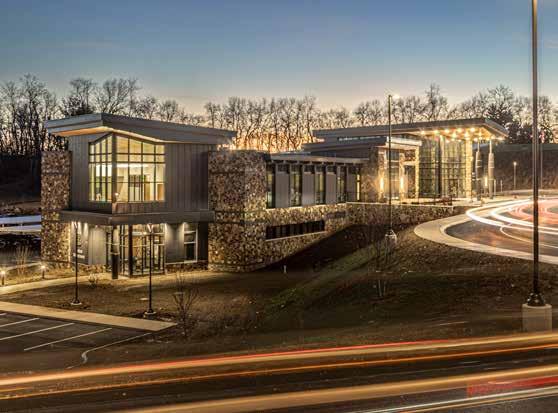
South Fayette Township Municipal Center
CONTRACTOR:
DiMarco Construction Company Inc.
OWNER:
South Fayette Township
ENGINEER:
Kimmel Bogrette Architecture + Site
MBA SUBCONTRACTORS:
A.J. Vater & Company, Inc.
Harris Masonry, Inc.
Paramount Flooring Associates, Inc.
Specified Systems, Inc.






CONTRACTOR: Massaro Corporation
OWNER: Form Energy
ARCHITECTS: Stantec
MBA SUBCONTRACTORS:
Abate Irwin, Inc.
Bruce & Merrilees Electric Co.
Harris Masonry, Inc.
HOFF Enterprises, Inc.
Kalkreuth Roofing & Sheet Metal, Inc.
Lisanti Painting Company
Matcon Diamond
Schindler Elevator
Steel City Scaffolding of Pittsburgh
W.G. Tomko, Inc.

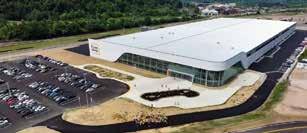
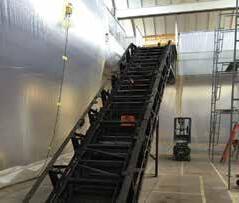
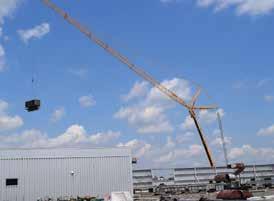
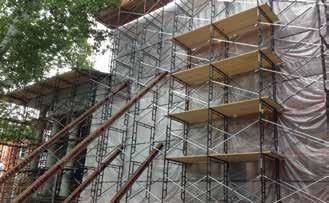
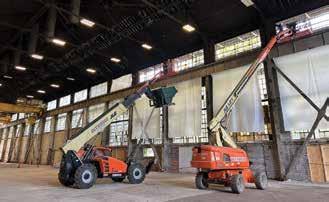
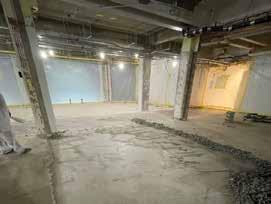


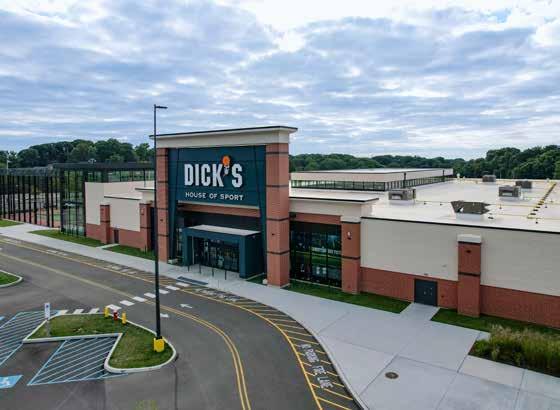
Dick’s
House of Sports
CONTRACTOR:
Rycon Construction, Inc.
OWNER:
Dick’s Sporting Goods
ARCHITECTS:
Fox Design Group
MBA SUBCONTRACTORS:
Bristol Environmental, Inc.
Costa Contracting, Inc.
Marsa, Inc.
Noralco Corporation
Specified Systems, Inc.
Swank Construction Co. Inc.


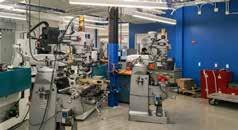
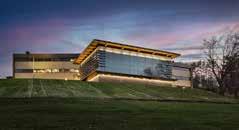



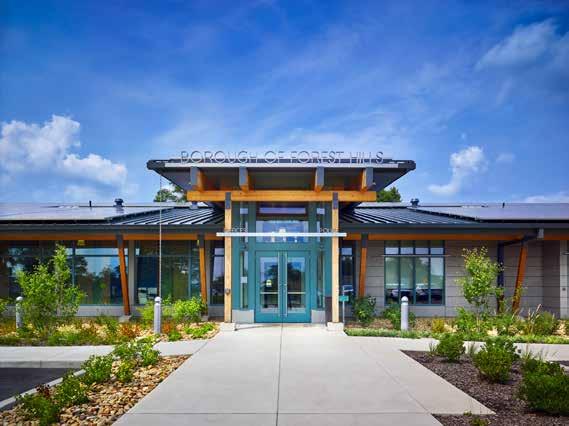
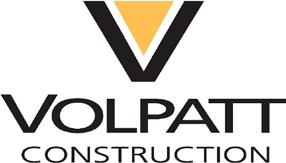
# W e A r e V o l p a t t ustrial institutional
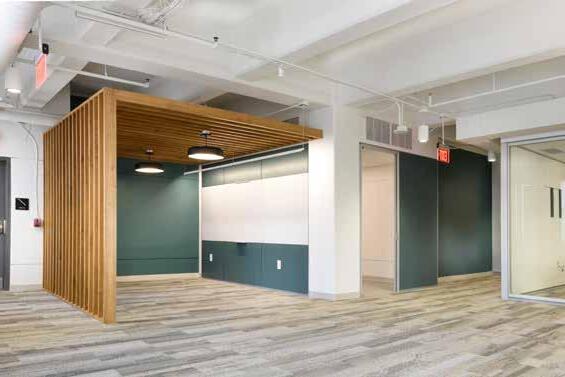
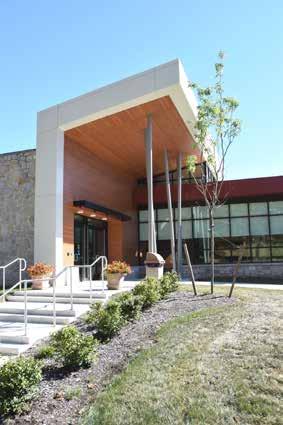


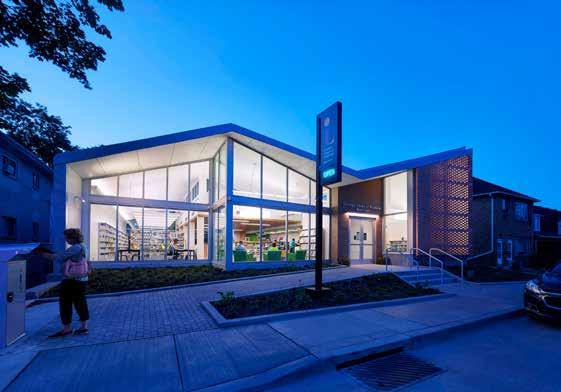





These are the hallmarks the region’s union construction trades and contractors bring to the jobsite everyday. Our professional tradespeople and contractors bring the dreams and visions of our fast-growing region to life with a dedication that only those who live here, work here, and raise their families here can commit to. It is, after all, our home, our legacy.
CONTRACTOR:
Volpatt Construction Corporation
OWNER:
Carnegie Museums of Pittsburgh
ENGINEER: Gensler
MBA SUBCONTRACTORS:
Keystone Electrical Systems, Inc.
Matcon Diamond
McKamish, Inc.
T.D. Patrinos Painting & Contracting Company
Wright Commercial Floors

We are also committed to providing opportunity for all who share these values and want to pursue a lifelong, lucrative and satisfying career. For more information on building with our union trades and contractors, or to explore career opportunities, please visit www.buildersguild.org where you will find direct links to our Trade Unions, Joint Apprenticeship Training Centers and Contractor Associations.



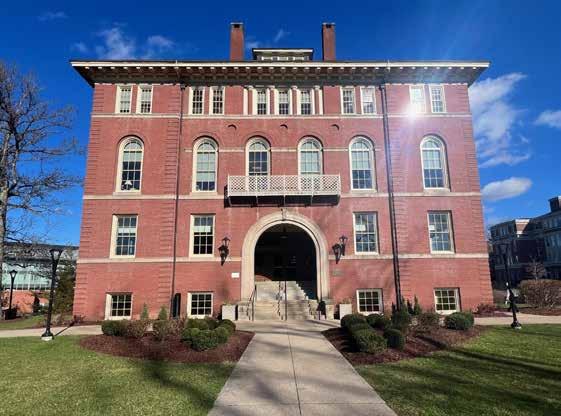
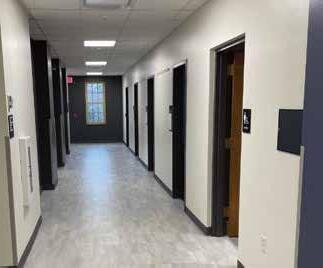


Over $10 Million
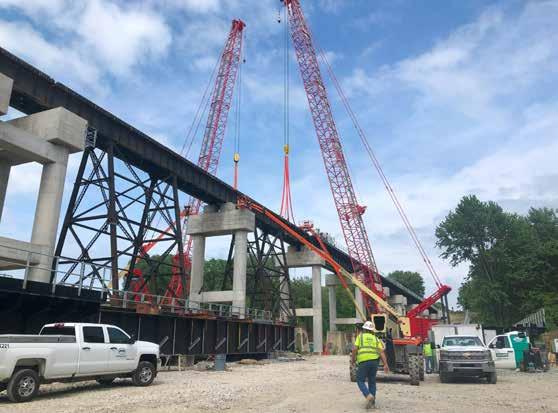
Norfolk Southern Conneaut Creek Bridge
CONTRACTOR: Mascaro Construction LP
OWNER: Norfolk Southern Corporation
ENGINEER: HDR
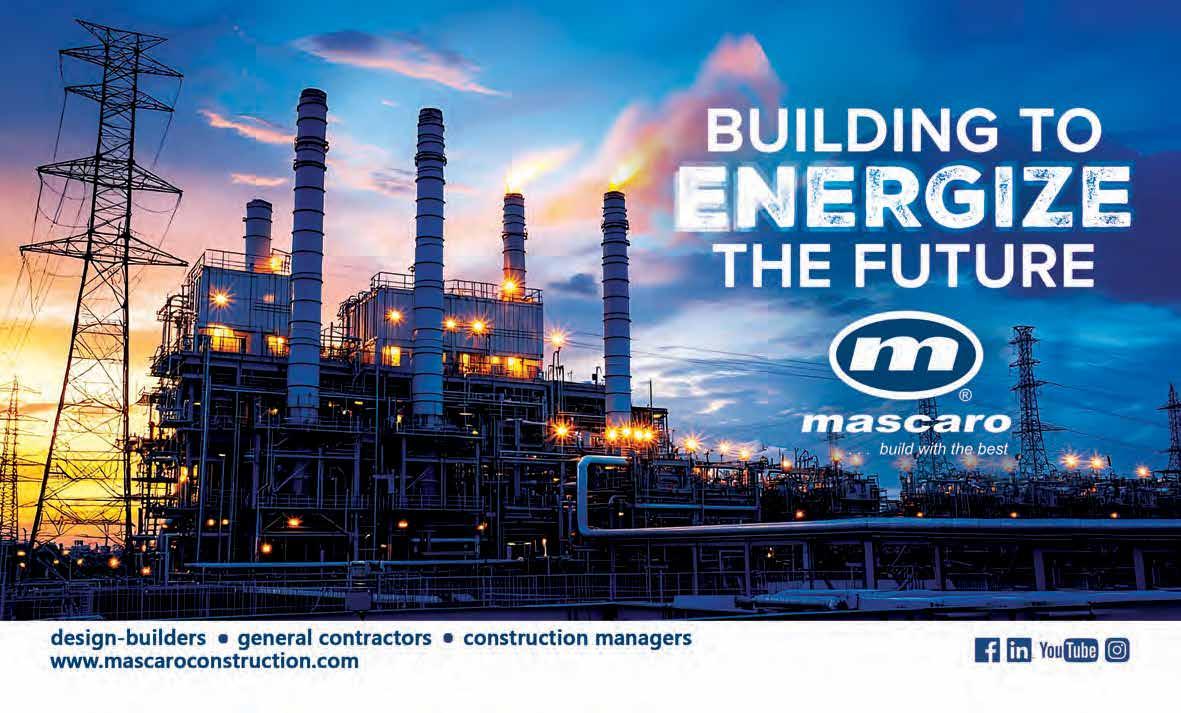
$2 to $10 Million
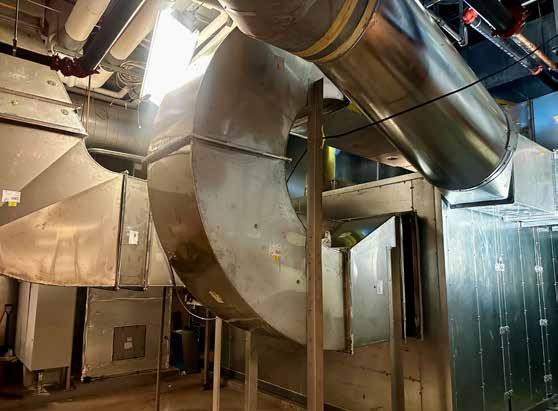
CONTRACTOR: McKamish Inc.
OWNER: Allegheny Health Network
ENGINEER: FMRW
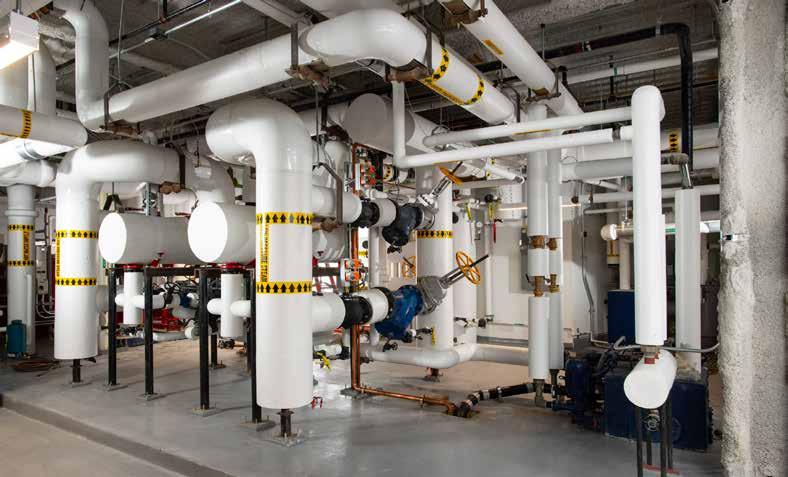


Carnegie Music Hall LED Lighting
CONTRACTOR: Sargent Electric Company
OWNER: Carnegie Museums of Pittsburgh
ARCHITECT: Gensler
International Brotherhood of Electrical Workers
L ocal Union No. 5
5 Hot Metal Street • Southside • Pittsburgh, PA

For more than 125 years , I.B.E.W. Local 5 has been lighting up Pittsburgh’s sports arenas, its hospitals and its skyscrapers.
Acrisure Stadium, PNC Park, Pittsburgh International Airport, PPG Place, UPMC Children’s Hospital of Pittsburgh and the new FNB Tower. Behind Pitts burgh’s major buildings is I.B.E.W. Local 5.

NATIONAL MARKET UPDATE
The first estimate of gross domestic product (GDP) growth for the final quarter of 2024, issued on January 30, confirmed that the U.S. economy continued to defy economic gravity. Despite higher interest rates and inflation that remained near three percent, U.S. consumers spent 4.2 percent more in the fourth quarter, pushing GDP 2.4 percent higher than the third quarter.
GDP growth for the full year measured 2.5 percent higher than at the end of 2023, the same growth rate from 2022 to 2023. That is a full percentage point higher than most forecasts at the start of 2024. Above average consumption and solid business investment made up for weak housing and non-residential investment. With unemployment low and wages growing above the rate of inflation, economists expect the economic momentum to continue through the first quarter, even though business investment in buildings and equipment slowed in the fourth quarter, likely in response to uncertainty about the impact of new policies from the Trump administration.
The stronger-than-expected growth and solid labor market were the main reasons cited by Federal Reserve Chair Jerome Powell following the Fed’s decision to keep its Fed Funds rate unchanged on January 29. In his remarks after the Federal Open Markets Committee concluded its meetings, Powell asserted that rates remained restrictive to economic growth and restated the central bank’s belief that inflation would ease towards the two percent goal by 2026. Markets eased following the remarks, with bond traders betting that
the next rate cut will not happen until June or later.
Powell did raise one red flag about the labor markets, noting that hiring had weakened considerably since 2023, which would mean that an increase in layoffs would bring higher unemployment more rapidly.
Most economists share Powell’s assessment of the U.S. economy. There are fewer economists predicting a potential recession in 2025 than there were in recent years. The consensus is that the consumer will continue to generate enough economic activity to keep employment at or near the current high levels. Nearly all observers, including Powell, caution that the trade and immigration policies espoused by the Trump administration are potential threats to economic growth that remain unknown. Tariffs have the effect of driving prices higher while chilling growth, a condition commonly called stagflation.
First quarter growth is expected to be at or above three percent, driven by businesses that aggressively built inventory ahead of tariffs. Assuming that some of the tariffs imposed by the administration remain throughout 2025, stagflation should drag GDP below two percent for the full year.
PNC’s chief economist, Gus Faucher, presenting the bank’s outlook for 2025, was optimistic about the economy while noting the potential headwinds. PNC sees slower growth in household income and consumer spending in 2025, but not so much as to blunt modest growth. While consumer debt levels are rising, incomes are going up even more quickly, and household debt burdens relative to incomes are lower than they were right before the pandemic and much lower than they were right before the Great Recession.
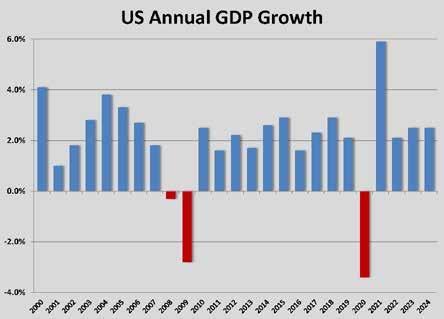
Source: Bureau of Economic Analysis.
Kevin Thorpe, Cushman & Wakefield’s chief economist, described the U.S. economy as being in “the sweet spot” as 2025 began. Thorpe pointed to GDP growth above 2.5 percent during a period of full employment, with core inflation falling close to the desired two percent range, as conditions that mostly eliminate the risk of recession. Another key metric cited in the Cushman & Wakefield economic update was strong corporate profits. Thorpe noted that layoffs historically increased following three or four quarters of declining profits and expected that unemployment would therefore remain close to four percent throughout 2025.
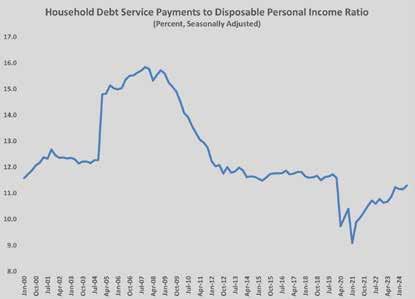
The February 7 Employment Situation Summary showed higher-than-expected job creation and reported the final revisions to employment growth for 2024. The headline new hiring hit 237,000, with upward revisions of 100,000 jobs
in November and December 2024. With those revisions, hiring averaged 183,000 per month in 2024, a decline of 49,000 per month from the average in 2023. Below the headline number, however, were signs that validated Powell’s concerns about the pace of hiring.
Private payrolls averaged only 149,000 per month last year versus 192,000 in 2023, according to payroll processor ADP. Moreover, Census data showed government and healthcare added 51 percent of the new jobs in 2024. Private healthcare, which is funded significantly by federal and state programs, added more than 57,000 jobs each month in 2024. Government hiring cooled somewhat from 2023 to 2024 but still accounted for 37,000 jobs each month. The remaining 90,000 jobs per-month pace would be inadequate to absorb a marked increase in unemployment.
To the upside, layoffs remain at historically low levels through the first two months of 2025. For the 12 months back to February 2024, initial claims for unemployment compensation averaged 223,000 weekly, and the number of new claims at the end of February 2025 matched the three-year weekly average of 219,000. The low level of unemployment

RELIABLE PERFORMANCE - INSIDE AND OUT CONTRACT GLAZING FOR 31 YEARS




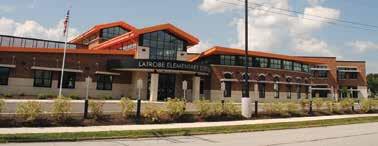



Despite higher inflation since 2021, household debt remains low as a share of disposable income. Source: Board of Governors of the Federal Reserve System (US), Household Debt Service Payments as a Percent of Disposable Personal Income.
remained steady, even as the pace of new hiring fell 75 percent. That suggests that the demand for workers overall is strong enough to absorb weaker demand or excess employment in sectors of the economy that are struggling, which is a good sign for long-term unemployment concerns.
Similarly, other key economic indicators that softened in 2024 have remained steady, albeit at lower readings, while the overall economy expanded. Consumer confidence continued to decline slightly in January, although coming in at levels above those that suggest a recession.
The Conference Board’s Consumer Confidence Index fell by 5.4 points from December, following a 3.3 point drop the previous month. Consumer expectations also declined slightly.
The Conference Board’s chief economist, Dana Peterson, noted that confidence was higher among consumers in the lowest income cohort, while those earning more than $125,000 annually registered the sharpest decline.
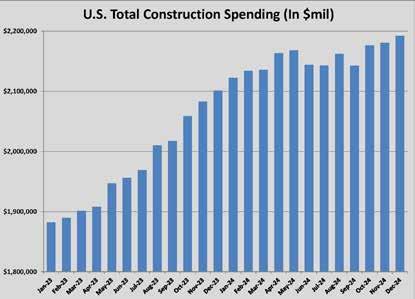
The University of Michigan’s consumer sentiment index also slipped in February, falling 3.3 points to 67.8. February’s dip in sentiment followed a 2.9 point drop from December to January. The February reading was the lowest since similar
levels in June-August 2024.
Despite lower confidence, consumer spending remained robust. The National Retail Foundation (NRF) reported on February 11 that retail sales jumped 5.4 percent in January












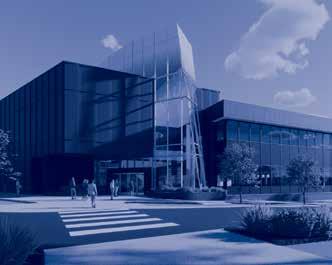


PITTSBURGH’S INNOVATIVE BUILDER






























From extensive facilities focused on tackling some of the world’s most challenging issues to intricate interior projects where the minor details are the most crucial, Turner Pittsburgh has the local expertise to complete the region’s most complex projects, with the national resources to enhance the services we provide to our clients.
Total construction spending has plateaued since price escalation returned to normal levels in late 2023. Source: U.S. Census Bureau.
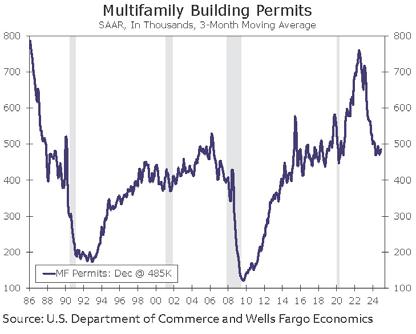
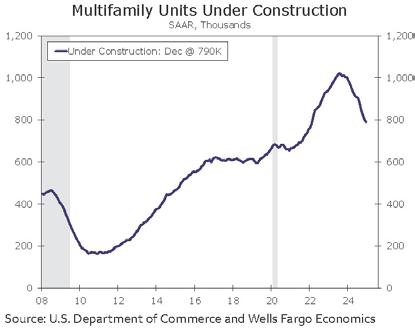
compared to a year earlier. Sales were higher in seven of the nine areas covered by the NRF’s Retail Monitor. The year-over-year increase outpaced consumer inflation by 2.4 points. In contrast to the NRF report, the Commerce Department reported on February 14 that retail and service sales fell 0.9 percent in January. Economists anticipated a 0.4 percent decline, due to an expected drop in light vehicle sales, but the unusually cold weather dampened shopping and dining.
The Standard and Poor’s U.S. Manufacturing Purchasing
Manager’s Index (PMI) rose to 51.2 in January, the first positive reading for the index since June 2024. The Institute for Supply Management (ISM) PMI edged into positive territory to 50.9 in January, the first positive reading from purchasing managers since October 2022. ISM respondent managers reported increases in both new orders and production, both several points above neutral. There were more in purchasing managers reporting increased price pressure, 55.1 percent versus 52.5 percent in December.
The U.S. housing market ended 2024 on an upbeat note, but the lower volume year-overyear reflected challenging market conditions. The Department of Commerce reported on January 19 that housing starts jumped 15.8 percent from November to December. The monthly gain was entirely due to a 61.5 percent spike in multi-family units; however, that increase was attributed to post-hurricane reconstruction in southern states, where the number of apartment units that were started doubled from the previous month. Overall, the 1.499 million units started in December were still 4.4 percent lower than a year earlier.
Year-end data on new home sales showed a similar spike in December, highlighting the correlation between the early September dip in mortgage rates and new home construction contracts. Buyers rushed to sign contracts while 30-year mortgage rates dipped to six percent. That surge showed up in sales and starts in the last months of 2024. As rates moved back to seven percent by October, new home sales cooled.
Multi-family fundamentals improved markedly throughout the year, despite a near record high number of units delivered to the market. Roughly 25 percent fewer units were started in 2024 than in 2023 and the total number of units under construction fell by 21 percent. With home prices escalating at above-average rates again in 2024, the demand for rentals remained strong, which improved absorption and kept occupancy levels even despite the increased supply. There is little to suggest that home affordability will improve in 2025, which should keep apartment demand ahead of construction as the year unfolds.
Low inventory of existing single-family homes for sale kept demand for new construction high, but new construction still lacked sufficient available lots to provide relief to the market. New single-family home starts finished 2024 above 1,000,000 again, but the rebound in mortgage rates in the fourth quarter blunted momentum. After testing the six percent level in late September, interest rates for 30-year
The slowdown in new multi-family projects in 2024 helped halt the three-year trend of increasing vacancy.
mortgages jumped a full percentage point by year’s end. Forecasts for long-term rates offer little consolation for buyers and homebuilders for the coming year.
The February 12 report on inflation in January was greeted as a surprise by the media, but January’s inflation will have little real impact. First, inflation tends to run hotter in January because of the larger share of annual wage increases and apartment lease renewals that happen at the beginning of the year. (This is exaggerated when wage hikes are running ahead of inflation.) Each of the past three January readings brought headlines of “surprise” increases. Second, the arc of Federal Reserve policy is a continued pause. Bond market trading indicated only a 2.5 percent chance of a rate cut in March ahead of the January inflation report. Bond traders are betting that there is less than a one-inthree chance of a Fed Funds cut as late as the July meeting.
While much of the media chatter about interest rates will focus on the Federal Reserve’s policy direction, long-term debt investors are disconnected from Fed action, which impacts the short-term rate market. Residential and commercial mortgages are tied to long-term bond prices, which are currently elevated by investors’ concerns about future U.S. government debt service and the policy initiatives of the Trump administration. The latter are still uncertain but policies that have been articulated, such as cutting taxes, imposing high tariffs, and purging the workforce of undocumented workers, are either inflationary or deficit building policies.
Markets have priced in little or no reduction in short-term rates in 2025. Because of the Fed cuts in 2023-2024, interest on construction loans (which vary with short-term rates) is considerably lower than mid-2023. That should stimulate construction on projects that are not constrained by higher long-term borrowing costs. For the most part, however, the interest rate environment will be consistent throughout 2025. That will only change if there is an unexpected decline in the economy, a turn of events that would have a different chilling effect on construction. BG



Avison Young creates real economic, social and environmental value as a global real estate advisor, powered by people. Our integrated talent realizes the full potential of real estate by using global intelligence platforms that provide clients with insights and advantage. Together, we can create healthy, productive workplaces for employees, cities that are centers for prosperity for their citizens, and built spaces and places that create a net benefit to the economy, the environment and the community.




Designed and Built to Get Results
For more than a decade, DFL Legal has provided companies with the most effective solutions in resolving unique construction and engineering disputes.
Our success has been achieved by offering our clients proven, big case experience, along with the efficiencies and flexibility of a boutique firm.
Find out how our experience can be put to work for you.
WHAT’S IT COST?
The report on January’s consumer and producer prices raised fears about inflation again. Both the consumer price index (CPI) and producer price index (PPI) for final demand – a measure of all finished goods and services – rose 0.7 from December to January. Compared to a year before, CPI was 3.0 percent higher, and PPI was 3.5 percent higher.
While it is alarming to see the rate of inflation increase after nearly three years of monetary tightening, the levels in January may not reflect reinflation. Both consumers and producers were hit by a spike in fuel prices that exceeded 10 percent. A 5.7 percent jump in traveler accommodation services accounted for one-third of the PPI gain, according to the Bureau of Labor Statistics. January typically sees the largest share of annual wage increases and lease renewals, which tends to push inflation above the trend for the first month of the year. That has been the case for each of the past three years.
January saw inflation for construction that was also ahead of the 2024 trends. PPI for new nonresidential buildings leaped ahead 0.3 percent from December; however, the year-over-year index for that inflation rose only 10 basis points to 1.7 percent. Since turning positive in July 2024, that specific metric for escalation has risen 0.5 percentage points. The PPI for specific building types rose more moderately yearover-year, ranging from 0.4 percent higher for new industrial buildings to 2.9 percent higher for new office buildings. Inflation for specific new, repair, and maintenance work by specialty contractors was similarly moderate, ranging from a high of 2.9 percent for roofing contractors to -0.3 percent for plumbing contractors.
The largest increases from December to January were for #2 diesel fuel (up 3.6 percent), asphalt paving mixtures (14.8 percent), and iron and steel scrap (5.6 percent). Only lumber and plywood saw a decrease of 0.5 percent. Notable increase from 2024 to 2025 in January were for paving mixtures (up 8.6 percent), concrete pipe (8.0 percent), gypsum materials (5.5 percent), and copper and brass mill shapes (12.3 percent). Despite gains month-over-month, fuel prices were off 6.6 percent compared
to a year earlier. Likewise, the PPI for steel mill products (off 16.6 percent) and iron and steel scrap (-12.4 percent) were markedly lower than January 2024.
Compared to the report for January 2024, however, there were significantly fewer index categories in the red year-overyear. Only six categories were negative compared to January 2024 and three of those were related to steel, which is priced lower across all industries. Based upon history, this suggests the period of declining prices has ended. With tariffs looming for a number of items critical to construction, the escalation trend for 2025 is higher. How much higher will depend upon how much the tariffs slow the economy overall. BG
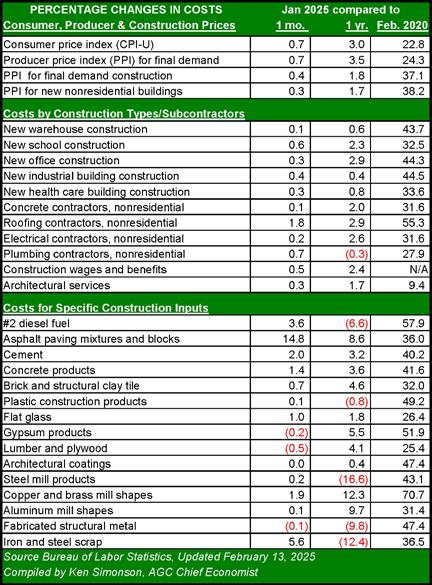

Energy Market Update
Constellation Energy proposes reactivating a portion of the Three Mile Island nuclear plant to supply energy to Microsoft data centers. Photo by Dobresum.
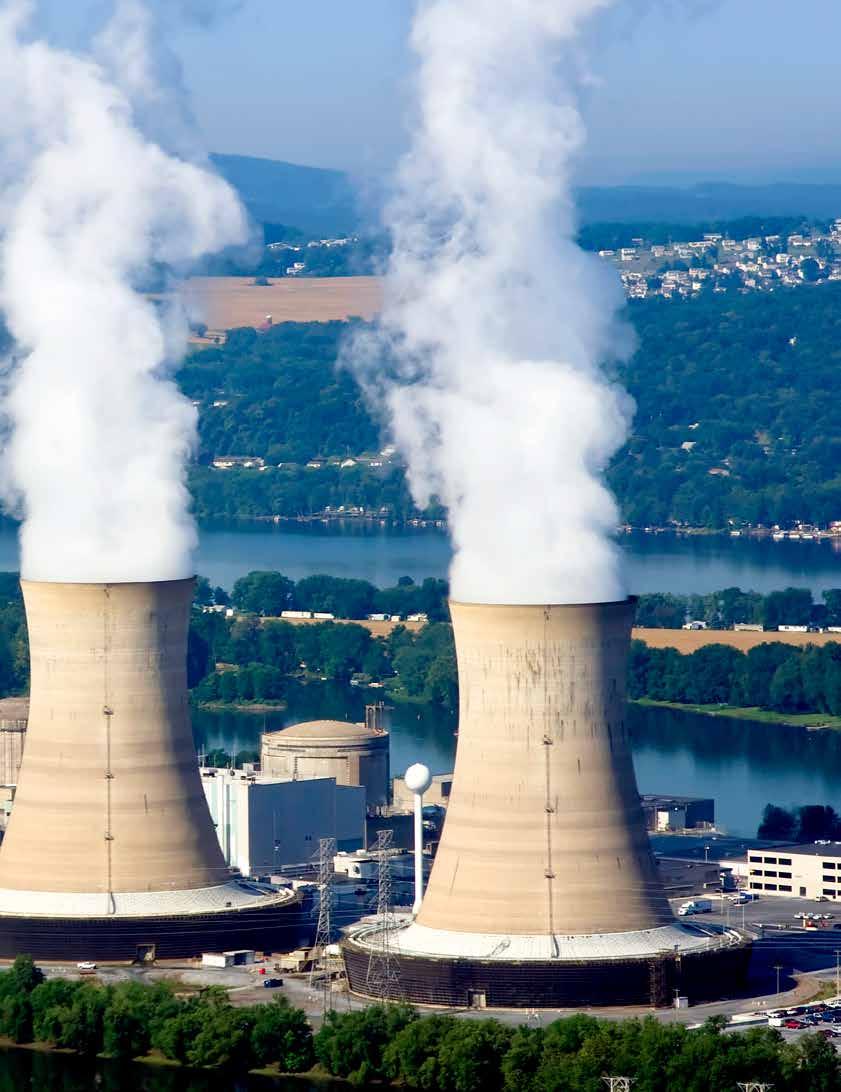
Despite warnings from energy producers, real estate developers, engineers, and many other professionals, there was a looming energy crisis as 2025 began that has the potential to derail much of the growth agenda in Western PA. The consequences – intended and unintended – of decades of policy decisions have left the U.S. energy grid in poor condition to meet the surging demand from households and businesses.



Photograph:
Generations of the Martini Family
Photographer: Mike Christ
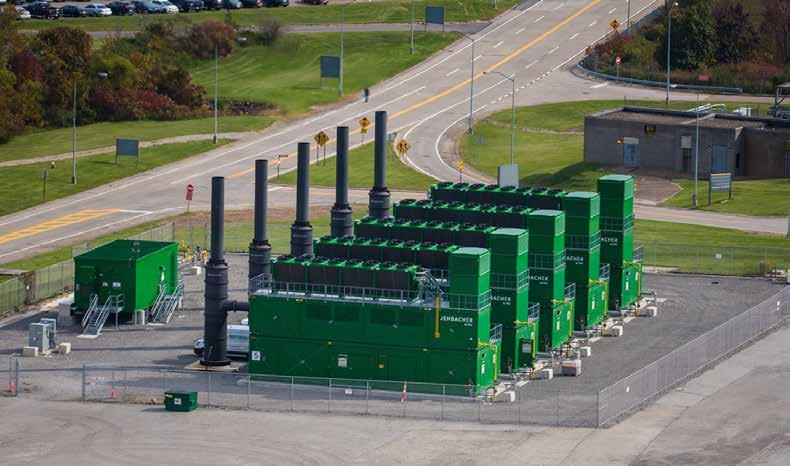
The current problem of imbalanced supply and demand is an unintended consequence of what was wellintended policy 20 years ago. Following summers of massive power outages in several major cities, the federal government changed policy to interconnect electric capacity so that individual regions had a reliable source of power as a backup. The policy goal has mostly been met. You need only look at the travails of Texas and California – two states that opt out of the interconnected grid – to see the benefits of participating. But the nature of interconnection, and of a large regulatory structure, makes it difficult to adapt to changing market conditions.
A couple of recent changes in the market have revealed how vulnerable the region’s energy infrastructure is to unexpected changes. One in particular, the rise of data centers supporting artificial intelligence (AI) applications, is threatening to wipe out the supply of electricity to all other new users and has spawned creative solutions that could shift the supply infrastructure.
Since the Great Recession, when the shale gas play offered the potential for rapid expansion of power generation, almost all factors impacting energy supply have exacerbated the imbalance. Regulations accelerated the retirement of legacy power generation. Incentives for alternative power generation drove rapid expansion and decline of wind and
solar production, although adoption of the latter is growing again exponentially. The bureaucratic and regulatory entanglement of the regional energy grid managed by PJM Interconnect ground the integration of new supply to a near standstill, blunting the impact of whatever potential innovation or source of supply might bring. Even good things, like federal incentives for new manufacturing capacity, have fostered problems.
In July 2024, the results of PJM’s annual Base Residual Auction (BRA) seemed to wake the market up. Power generators hiked their bids for ensuring adequate electricity for 20252026 by 570 percent. That hike rocked the utility world and ensured that consumers and businesses will be paying much higher rates in the coming year.
The source of this impending surge in prices is the growing imbalance between supply and demand. Power plant retirements have accelerated at the same time as demand. The answer to how we got to this predicament is similar to the old line about how you go bankrupt, gradually and then suddenly.
Booming Demand, Tightening Supply
In its white paper, How Private Equity Can Capitalize on Electrification: Trends in the Built Environment (see page 67),
The gas-fired generators at the Pittsburgh International Airport microgrid provide 22 MW of off-the-grid backup capacity. Photo by FlyPittsburgh.
global financial consultant FMI estimates that U.S. energy consumption will grow by another 15 percent by 2050. FMI cites the growth in data center operations that is driven by AI as one of four major trends pushing consumption higher. In 2015, data centers consumed approximately 320 terawatts of electricity. (A terawatt is the energy equal to one trillion watts per hour.) That number should double by 2027.
The expansion in load is coming from numerous sources. While the headlines point to AI data center growth, demand is also increasing from consumers because of greater use of electronics, conversion of gas to electrical equipment or appliances, and growing adoption of electric vehicles. Businesses are experiencing similar adoption of more electric over fossil fuels, but at a greater scale.
“The global trend on energy consumption was turning down in all countries but, given the increase in computing needs and general electrification around the globe, consumption started growing again,” says Aurora Sharrard, assistant vice chancellor for sustainability at the University of Pittsburgh. “Part of it is the increase in electrification in general and part of it is bringing electricity to more people around the planet. There’s been population growth, square footage growth, and overall increase in electrification.”
Booming demand for electricity is not confined to the U.S. Driven by China, India, and the developing nations, global demand for electricity is growing at a faster rate than in the
U.S. Efforts to stymie global warming are shifting the source of power from fossil fuels to electricity. The International Energy Agency (IEA) estimates that demand for electricity will grow six times as fast as the demand for power overall. The increase in demand is driving a rapid expansion in investment in the electrical distribution grid worldwide. That, in turn, is disrupting the electrical equipment supply chain in ways that are impacting the ability of utility providers to respond.
That summer 2024 auction was an alarm bell that suppliers of energy, including PJM, had been warning was coming for years.
Depending on market and environmental conditions bids are somewhat volatile year-to-year. An unexpected cold winter or unusual addition to capacity, for example, can swing bids higher or lower than might have been anticipated the previous year. Such volatility pales in comparison to the price swing from the July 2024 auction. Prices for the past few years have been at the lower end of a range from $2.1 billion to $10.9 billion over the past 10 years. (Duquesne Light’s price in that time ranged from $11,000 to $51,000 per megawatt [MW] per year.) The aggregate price for 2025-2026 will be $14.7 billion. It is the removal of old supply without replacement of new that triggered the current hyper-volatility.
For Pennsylvania residents and businesses, the market has had an additional layer of complexity since the commonwealth mandated the breakup of vertically-integrated energy
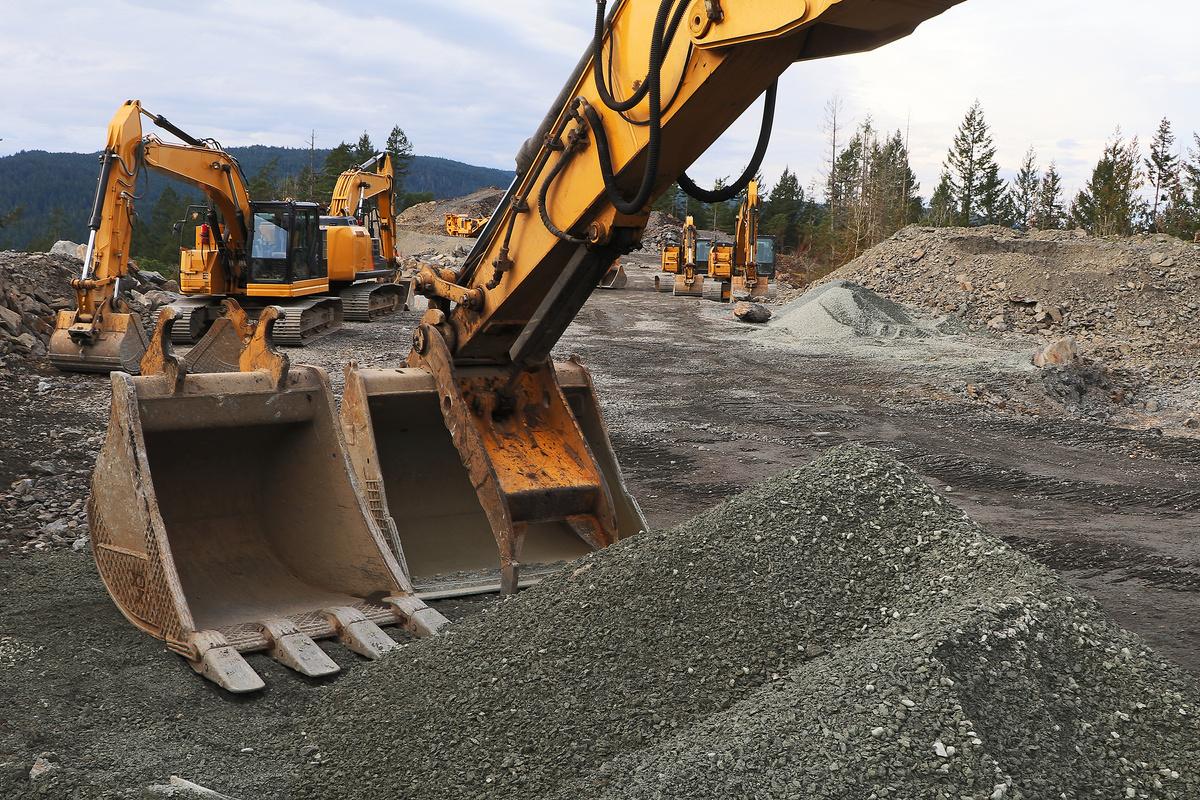

companies in the late 1990s. Power generation and distribution are separated, meaning that the providers, firms like Duquesne Light and Allegheny Energy, are customers of the power plants rather than owners of them. The same is not true for Duke Energy or American Electric Power in Ohio or Dominion in Virginia. Power generators sell electricity to PJM, which attempts to balance the supply and demand by locking in prices from the generators. The BRA auction requires generators to gauge future market conditions and estimate their lowest price to guarantee a reliable supply of electricity. The spike in prices from 2024 to 2025 reflects the generators’ concerns about the steady removal of capacity from the marketplace.
PJM’s estimates of supply and demand reflect the problem. Peak load is expected to increase by 3,000 MW from the previous auction until mid-2025. At the same time, generators’ capacity bids at the 2024 auction were 6,600 MW lower. Over the next five years, the planned retirements of 19 coal-fired power plants will drain another 12,700 MW from the grid. Plants that PJM says are at risk of retirement by 2030 total 58,000 MW of capacity.

A shortfall is in the cards unless there is a reversal of one or both of the supply and demand trends.
We Make Building Projects a Better Value
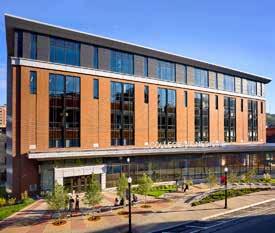
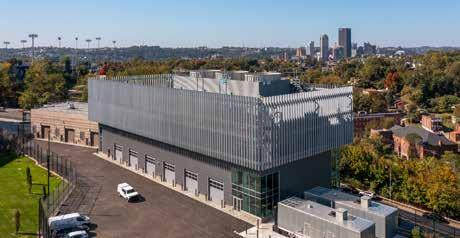
Power capacity prices for Duquesne Light’s jumped 833 percent from 2024 to 2025, matching PJM’s increase overall. Capacity pricing in Dominion’s footprint will see an increase of 1,373 percent. Source: PJM Base Residual Auction Report.
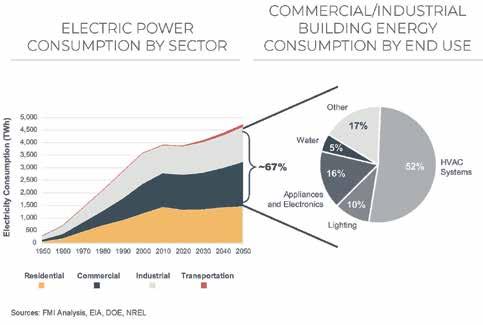
The increase in demand is coming from multiple sources; however, the boom in data centers has certainly focused the attention of the media and government on the supply and demand imbalance. There is a good reason for that. Developed to support AI applications, the new generation of


data centers require a physical and infrastructure footprint that dwarfs the data centers built five years ago.
“In a normal data center, the electrical design may be 100 or 200 watts per square foot. That is pretty dense. The most that we’ve done was almost 300 watts per square foot and we had to do some specialized things to make that work,” explains Jamie White, president and CEO of LLI Engineering. “At 300 watts per square foot it’s almost impossible to cool servers by air, and these AI data centers are about 1,000 watts per square foot. The server equipment that has these Nvidia chips are cooled by fluid.”
White says that the combination of the power demand of the servers and cooling equipment push the electricity usage by a factor of 10 times or more. He says LLI Engineering is involved in designing an on-site microgrid for a data center, like the one the firm designed at the Pittsburgh International Airport, but with a dramatic difference in scale.
“From revitalizing abandoned steel mills and industrial sites into thriving business and technology parks to transforming underutilized land into locations built for job-creating companies, RIDC has created a unique blend of economic development advocacy, community and regional revitalization, and high-quality job creation that could be a model for other regions that were once powerhouses of America’s industrial economy.”
Pre-order from Amazon, Barnes & Noble and booksellers around the region.
“We are designing a neighborhood microgrid right now where we are putting in two 250-megawatt plants that will serve data centers. Those won’t pull any power off Duquesne Light and the client will sell the excess electricity to Duquesne Light,” White says. “That is similar to what we did at the airport but that was only 22 megawatts.”
There are no such data centers approved for construction in Western PA as of early 2025, but it seems likely that more than one is in the cards. There are also several mega manufacturing opportunities evaluating sites in Western PA. These facilities are so large that they must account for on-site power generation. But numerous commercial and industrial opportunities that have far smaller power requirements are also struggling to find adequate electricity available.
Estimates on how serious the shortfall in supply will be vary, but there is no disagreement that the current path will leave Pennsylvania critically undersupplied with electricity. The gap between supply and demand will be 30 to 40 gigawatts by 2030, according to Duquesne Light’s vice president, energy policy and general counsel, David Fisfis. That translates to the power needed to electrify 30 million to 40 million homes.
In its 2025 Long-Term Load Forecast, published on January 24, PJM forecasts that its peak winter load will grow in 10 years by nearly 20 percent more than its 2024 forecast, and its peak summer load will be almost 17 percent higher than it forecasted a year ago. PJM pointed to five specific industrial
or manufacturing loads that it was not anticipating, including new data centers in 10 of its service zones. Duquesne Light was not among the zones mentioned, even though at least three of the data centers being proposed are in its footprint.
There is a degree to which the shortfall is the result of the accelerating growth in power usage simply outstripping new supply, which is a relatively recent phenomenon. The imbalance between generation and consumption in the various states within PJM’s footprint is, in part, because the long-term trend prior to this decade was flat or declining in states like Ohio, Maryland, or New Jersey. States where there are ample natural resources used in generating electricity, like West Virginia and Pennsylvania, continued to add capacity, which also allowed the states that consumed more than was generated to resist new capacity or take capacity offline.
Gov. Shapiro highlighted this imbalance in his January complaint against PJM to the Federal Energy Regulatory Commission (FERC). In his appeal to reduce PJM’s price hike caps at its next auction, Shapiro implied that Pennsylvania could consider leaving the grid agreement so that its power producers could serve Pennsylvania residents and be compensated for any energy exported to other states. This is the route Texas and California have gone with mixed results at best.
It is easy to point the finger at PJM for the current problem. The grid manager is tasked with balancing supply and
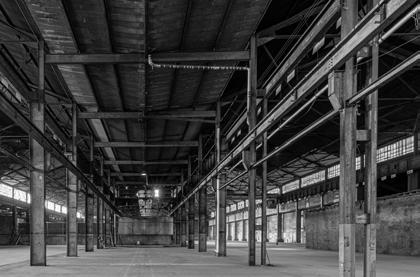
INDUSTRIAL REAL ESTATE ADVISORS
Genfor is an entrepreneurial, relationship driven commercial real estate services firm focused on industrial properties.
Whether you are an industrial business owner, investor, tenant, or developer, we are here to serve you and help you make informed and strategic real estate decisions.
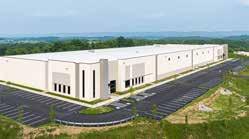
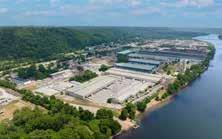
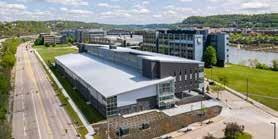

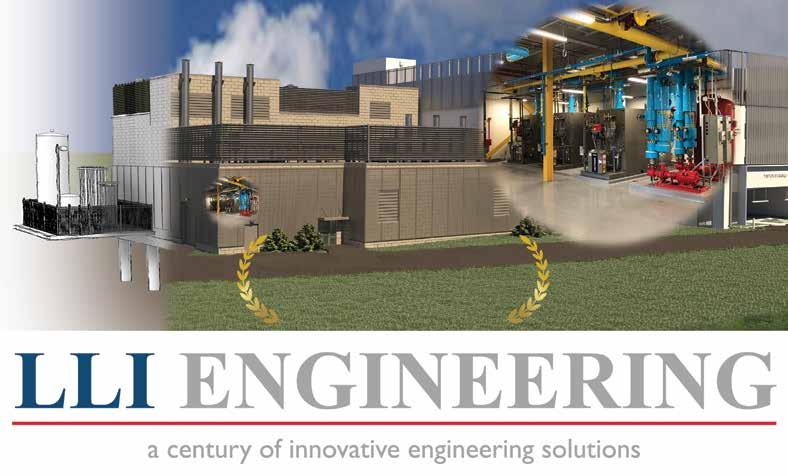


demand that it has virtually no control over. PJM reviews projects and only clears them for connection to the grid. It does not have approval and can only encourage state governments to incentivize more private investment in power generation. But what PJM can control, the pace with which it approves and adds capacity, is not changing quickly enough to respond to the coming crisis. Generators complain that the current backlog of applications to add supply are running three years to complete, meaning that the market is stuck with its current imbalances until at least 2027. For its part, PJM asserts that its backlog is filled with alternative energy projects because of the Inflation Reduction Act (IRA) and other incentives for green energy. Those projects are typically much smaller in capacity than a traditional fossil fuel plant but require a similar review time. That means the clogged PJM pipeline has less potential output than has traditionally been vying for space on the grid.
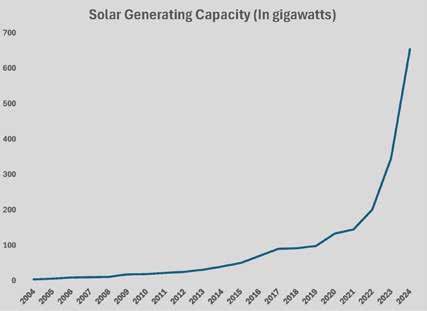
Solar capacity grew by 351 percent from 2021 to 2024. Source: International Energy Agency, Energy Institute, Bloomberg.
PJM asserts that its multi-year backlog belies the fact that it is approving new supply at a record pace, blaming the delays on excessive review by Pennsylvania’s numerous regulatory agencies. PJM’s senior lead for external communications, Dan Lockwood, notes that as of early 2025, more than 50 gigawatts of new generation project have cleared the interconnection queue but are not operational, with most not under construction yet.
“The projects that have not started construction usually have problems in one of three areas: supply chain, adequate financing, or siting issues with the municipality or state,” Lockwood says.
Filling the Gap
PJM touts its interconnection reform measures taken in 2023 to expedite the time from conception to generation. In response to a tripling of interconnection requests from 2018 to 2022, PJM proposed reforms that FERC approved in November 2022. Beginning in July 2023, review shifted from a “first come, first served” queue to a “first ready, first served” process that placed projects in line according to the project’s readiness to operate. This transition eliminated 118 of the 734 projects that were in line for review but not ready and will result in 616 projects clearing the process in 2024 and 2025. (108 of those are in Pennsylvania.) As Lockwood noted, other hurdles exist for most of these projects, including slow site approval and permitting.
Gov. Shapiro is proposing a “Lightning Plan,” a dramatic improvement in energy permitting that would include the establishment of the Pennsylvania Reliable Energy Siting and Electric Transition (RESET) Board to fast-track power generation projects. Shapiro also proposed an incentive program through an updated Pennsylvania Economic Development for a Growing Economy (EDGE) manufacturing
tax credit. That program would offer up to $100 million annually in tax credits for three years for generators who add reliable power to the grid, with an additional $49 million for hydrogen-based electric generation. The latter proposal must pass as part of the governor’s budget, which is hardly a sure thing.
A Lycoming County state legislator, Senator Gene Law, has proposed legislation that would establish a fund to assist in the financing of new power plants. Yaw, who chairs the Senate’s Environmental Resources and Energy Committee, is proposing what he calls the Pennsylvania Baseload Energy Development Fund to support the development of additional baseload power to Pennsylvania electricity distribution.
“Senator Law came up with the idea to mirror what Texas did about a year ago. We hoped to use a portion of the ‘rainyday’ funds to set up a revolving loan program that would take care of itself. The commonwealth was forced to spend down some of the rainy-day funds last year, so we had to go back to the drawing board to find other avenues for funding,” says Matt Osenbach, one of Senator Yaw’s staff who serves as executive director of the Environmental Resources and Energy Committee. “The consensus was to look at the EDGE tax credit. It appears we could repurpose in the ballpark of $65 million to $70 million annually over the next 20 to 25 years.”
Asked about the governor’s plan to use the EDGE credits, Osenbach acknowledges that Senator Law’s proposal will require lots of bi-partisan conversation to reach consensus. He notes that the Republican senators have strong opinions about what types of projects should receive high priority.
“Our caucus will probably dig our heels in that it has to be some sort of base load dispatchable generation. At this point the only new dispatchable base load generation we’re
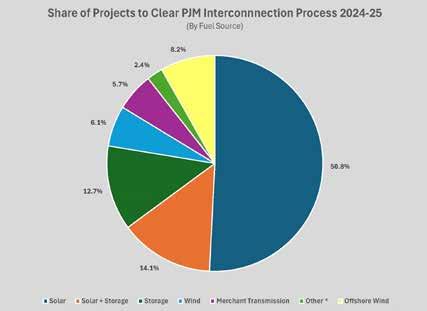
* Includes 1.647 gigawatts of natural gas generation and 51 megawatts of hydroelectric generation. Source. PJM Interconnection.
building in this country is natural gas,” he says.
The latter point Osenbach makes about generation sources is a key issue in the debate between proponents of fossil fuels and renewable energy. Rhetoric aside, there is an important distinction between the capacity of renewables and conventional power plants for reliability. Dispatchable power can be adjusted by grid operators on demand to meet variable demand. To date, dispatchable power is generated by coal-fired and natural gas-fired power plants, nuclear plants, and large hydroelectric plants. Non-dispatchable generation, typically solar and wind, are unable to be ramped up to meet intermittent demand, unless they are coupled with grid-scale battery storage.
Battery development and manufacturing are accelerating. Form Energy has been producing iron-air batteries in Weirton since June 2024 (see page 53) and has begun construction of an expansion that will result in a million-square-foot facility with 500 MW of storage annually. Iron air batteries avoid the environmental damage that result from lithium-ion battery manufacturing and cost 10 percent or less to make. EOS Energy, which will be building a $60 million new plant at the RIDC’s City Center of Duquesne site this year, manufactures zinc-based batteries that provide longer life with less damage to the environment than lithium batteries.
Unfortunately, no battery is being manufactured at a pace that can match the scale of renewable energy generation in the queue, let alone meet the looming shortage, until the end of the decade.
Gov. Shapiro also weighed in on a recent change at PJM, its Reliability Resource Initiative (RRI). Approved by FERC on February 12, RRI proposes to identify 50 larger-scale generation opportunities that could more rapidly increase the supply of electricity to meet the AI data center boom. Shapiro
expressed concern that PJM was bypassing state and local regulators, which could best identify potential problems or identify the most likely projects to advance, based upon the developer’s level of compliance.
Developers of smaller-scale sustainable projects oppose the RRI, claiming that it allows PJM to favor larger legacy generators and bypass smaller projects that have been in the interconnection queue since 2022. Others, including former FERC officials, expressed concern that RRI would elicit numerous legal challenges, some of which were likely to succeed and all of which would divert time and resources away from getting more electricity on to the grid.
New legislation introduced in the U.S. House and Senate in early February seeks to give Regional Transmission Organizations (RTO), like PJM, more flexibility to expedite review of dispatchable power plant projects. The GRID Power Act would allow RTOs and independent operators the opportunity to move a dispatchable plant to the front of the queue if the organizations can demonstrate that the project would bolster the grid’s reliability and resilience. FERC would be charged with reviewing these requests within 60 days before referring the project to the RTO for its review process. Like the RRI, the GRID Power Act is likely to give higher priority to fossil fuel plants.
In addition to RRI and its process reform, PJM was also approved by FERC to use its Surplus Interconnection Service initiative to allow new generators to use an existing generator’s unused capacity under certain circumstances. This could enable pairing a renewable resource with a battery to an existing generator. PJM has also requested permission to expedite the review of a replacement generator in the case of a deactivating source.
These changes, along with any executive or legislative initiatives, would enable the addition of more electricity to the existing grid. At the moment, however, there are also market-based problems that prevent the construction of new generation. The global boom in electrical grid investment has outstripped the capacity of the relatively small number of electrical equipment manufacturers to respond. The four major manufacturers have multi-year backlogs on transformers and turbines, and energy consultant Wood McKenzie reports that prices for transformers have risen by 60 to 80 percent since 2020.
Because of these market conditions, developers of the major projects making today’s headlines do not plan to connect to the grid. At present, design and construction teams are being assembled to build major data centers on at least five sites in metropolitan Pittsburgh. Participants are unable to provide specific details but could confirm that all five projects would involve the construction of a power plant to serve the
data center “behind the meter,” or off the grid. The same is true for the redevelopment plans for the former Homer City power plant site.
Building generation behind the meter is likely to be the preferred solution until the power grid is modernized.
On January 28, Chevron announced a joint development with Engine No. 1 and GE Vernova to help meet the demand for scalable, reliable power solutions to enable advancements in AI. The partnership will work directly with customers to develop power generation that is dedicated to and colocated with data centers. The partnership’s plans call for delivering up to four gigawatts of power that can increase with the data center’s needs.
Microsoft is taking a more unorthodox and controversial route to ensure power for its data centers. Constellation Energy announced on September 20, 2024, that it had signed a 20year power purchase agreement with Microsoft to provide electricity for its data centers generated by a re-opened nuclear reactor at Three Mile Island, south of Harrisburg, PA.
Three Mile Island’s last reactor, which was unaffected in the 1979 accident, was shut down in 2019 after an appeal to the commonwealth for financial assistance failed. Nuclear generation is not competitive with coal and gas, and current nuclear operators have told legislators that it is not economically feasible to add capacity – even with small
modular reactors – without government subsidy.
In Monroe County, OH, roughly 90 miles southwest of Pittsburgh, Ohio River Partners operates the Long Ridge Energy Terminal, a 485 MW natural gas-fired power plant that blends 15-20 percent hydrogen into its fuel mix. Long Ridge’s Hannibal plant was developed without government subsidy, but plans to use a 75 percent hydrogen tax credit by developing a data center campus that would be powered by the plant.
A hydroelectric power developer, Current Hydro, has proposed a string of generating stations along the Ohio River and Allegheny River basins. Hydroelectric generation is the most expensive, per megawatt, to develop, which is why Pennsylvania has seen so little hydro development despite its ample supply of rivers. What separates Current Hydro is that it positions hydroelectric generation as a climate technology and is backed by investment funds that are focused on longterm returns, both in terms of climate and financial benefits.
The projects Current Hydro has proposed are relatively small but accumulate to more than $600 million in construction costs. Current Hydro has begun the process of gaining FERC approvals and navigating the PJM and state regulatory processes. The projects are assembled into two packages:
• Three new plants to be built by Mascaro Construction on the Ohio River: 19.9 MW at Pike Island Dam in Yorkville,
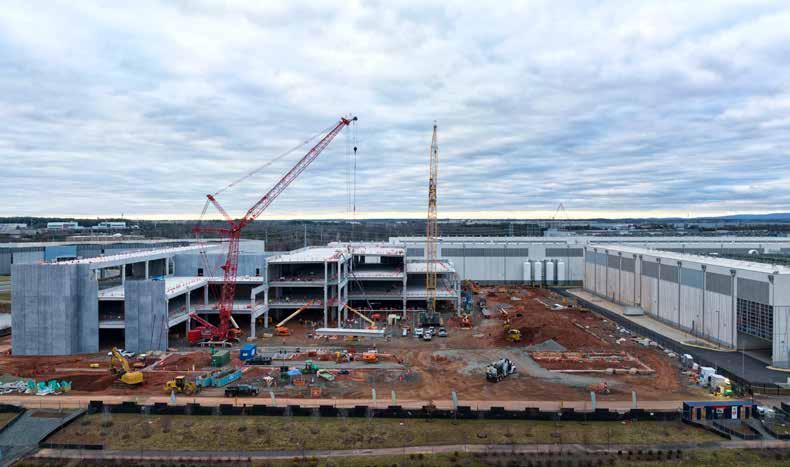
Data centers that are supporting AI, like this one under construction in Ashburn, VA, consume 25 to 50 times more electricity than data centers built five years ago. Photo by Gerville.

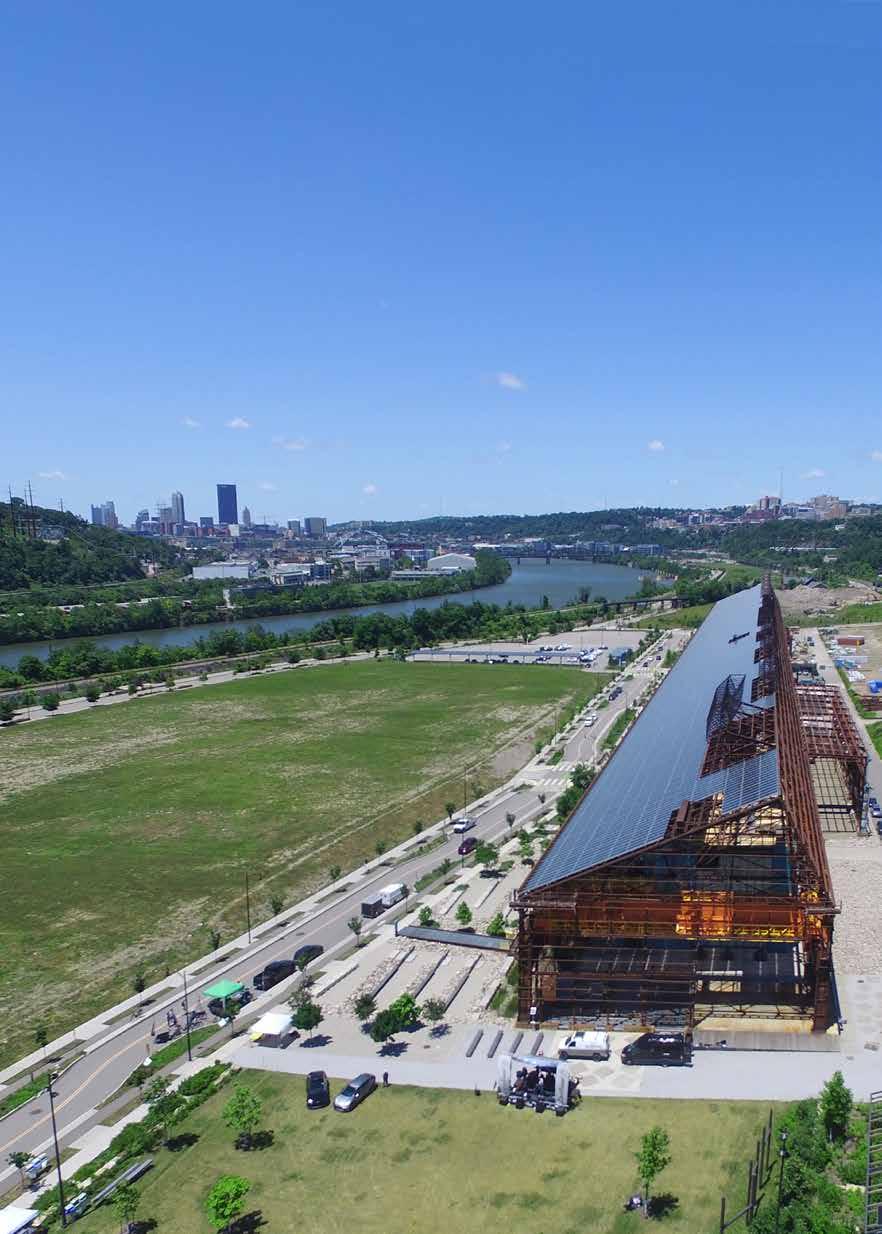
OH; 19.9 MW in New Cumberland, WV; and 28.5 MW at Robert C. Byrd Dam near Gallopolis, WV.
• Three plants to be built by Brayman Construction/ Massaro Corporation on the Allegheny River: 8.4 MW at Allegheny Dam 3 in Harmar Township; 6.35 MW at Allegheny Dam 4 in Harrison Township; and 8.4 MW at Dashields Lock and Dam in Edgeworth.
What about the 50 MW of renewable projects that PJM has cleared? For the near term, most remain in the development pipeline, working through municipal siting issues and higher construction costs. As these projects come to fruition, the additional generation will serve some of the demand growth, but renewable energy remains an intermittent source of electricity without some share of the generated electricity going to storage for use when the renewable sources are inoperable.
According to Green Building Alliance (GBA), getting renewable generation to the point where it can be dispatchable is still too expensive and would require significantly more renewable assets. GBA advocates looking at the grid to use renewable energy alongside all generation sources and suggests using a combination of battery storage, demand response, and curtailment to manage renewable variability. It points to a Duke University study released on February 11 that showed that the U.S. power grid could handle an additional 76 o 126 gigawatts of load if the new users – presumably data centers – could be curtailed by 0.25 percent to one percent of their maximum uptime.
The problem with curtailment, assuming new users would agree to it, is matching periods of stress for the grid to periods when curtailing usage would not cause harm to the business involved. Moreover, deploying the variety of approaches needed to use renewables to resolve the grid’s inadequacy would be complicated and, potentially, more costly than adding what is dispatchable today.
Reliability First is one of six organizations established under the authority of FERC to ensure a reliable and secure transmission of electricity after the 2003 blackouts. Reliability First monitors the electrical grid in parts of 12 states stretching from the Upper Peninsula of Michigan to New Jersey, including Pennsylvania. While the organization refrains from offering solutions, it is charged with raising concerns about security and reliable supply, including the problems of accelerated power plant retirements and resource adequacy. Among its major concerns is the essential reliability services that existing plants provide.
“Base load generating plants, such as coal and natural gas, operate differently than the new intermittent resources coming online. Base load generation provides things like voltage regulation and frequency control to the power grid that helps keep it stable. These new resources don’t yet provide those essential reliability services,” explains Diane Holder, vice president for entity engagement and
corporate services for Reliability First. “There are technologies being worked on for that, but they’re not available at scale yet. You need more capacity with renewables compared to a base load generating plant, maybe as much as seven times the capacity.”
As 2025 begins, the only renewable generation source that can approach reliability is solar. While it cannot avoid intermittency, solar power has the best opportunity to overwhelm the surge in demand through its own capacity growth.
The extraordinary thing about solar energy is the degree to which forecasts for its growth have been wrong. Even the most optimistic forecasters have underestimated the rate of development and acceptance of solar power. Experts at the IEA predicted in 2009 that it would take until 2030 before the installed capacity reached 250 gigawatts. That milestone was passed in 2016. That same year, Greenpeace forecasted that global solar capacity would be 921 gigawatts in 2030. In 2024, global capacity hit 1,420 gigawatts. The total installed capacity has outstripped five-year capacity forecasts by an average of 200 percent since 2010.
Three interrelated factors have driven the explosive growth in solar generation capacity. Increased scale has made manufacturing cheaper. Demand grows as the cost of production becomes cheaper. As demand grows, manufacturing increases to meet it. This virtuous cycle of production has driven the mass acceptance of cars, electronics, and now solar generation.
“For commercial and industrial solar, the interest level is extremely high. It is still being driven by the IRA and the incentives that are in place for solar,” says Jack Scalo, president and CEO of Scalo Solar Solutions. “There still is interest in solar from a renewable energy standpoint. It is the only way that a private corporation can impact and reduce their energy cost on the back side of the meter. It gives them a chance to own their own power plant and reduce their expenses.”
Because 80 percent of solar arrays are installed on roofs, many large consumers of electricity have the physical plant to add on-site generation without adding new facilities. Solar can not yet add reliability to the grid, but it can remove load demand.
Scalo estimates that his business has doubled since the IRA was passed, with a backlog that shows continued growth. He sees indications that anxiety over the potential for the Trump administration to kill the IRA has increased demand, although he sees the elimination of the tax credit as unlikely.
“I don’t know if solar will ever be able to fully cost justify without subsidy. All energy sources are subsidized to some degree,” Scalo says. “The speculation in the solar industry is that if the administration makes any changes to the IRA it will shorten the term but increase the percentage added for domestic content in solar materials, because President Trump is focused on growing U.S. manufacturing.”
The push to replace fossil fuels with renewable energy sources, which may have peaked with the passage of the IRA, is a supply growth strategy. What seems to have taken a back seat, at least in terms of public conversation, is limiting demand through energy conservation and efficiency. Perhaps that is because high-performance building design has become commonplace, but Sharrard is concerned that conserving electricity is not being prioritized as highly as generating electricity.
“It is surprising that there has been less conversation about energy efficiency in the last year or so, especially with all the focus on AI and data centers. We have known electricity consumption was going to go up, even if we couldn’t predict how much AI and data centers were going to contribute,” says Sharrard. “I think the questions we all should be asking ourselves is can we use efficiency to balance that growth? Can we use other structures, like batteries, to help achieve what we expect as a society while not continuing to overburden our planet?”
Energy efficiency may not have slipped as a design and construction priority, but it has faded as a hot topic in public discourse. An October 2024 survey from pollster YouGov sheds light on how U.S. voters believe the transition to cleaner energy should proceed. Voters said cost and reliability are more important than possible climate impacts. When given four different priorities to choose from, “cost of energy” was chosen by 37 percent of voters, followed by “availability of power” (36 percent), “effect on climate” was chosen by 19 percent. Voters like solar (38 percent) and natural gas (26 percent) for producing power. Voters are reluctant to pay extra to fight climate change. When asked about a hypothetical $1 per month fee on their bill, 47 percent said they would support it, while 43 percent were opposed.
These findings do not mean that U.S. voters – or the general population – will resist efforts to change the way electricity is generated; however, it seems clear that advocates for alternatives to adding more fossil fuel generation to the grid – including a “megawatt saved is a megawatt earned” approach – must re-engage in educating the public.
Educating the public would seem to be a good approach for policy makers too. While there appears to be a sense of urgency for both industry and the government, that may not be the case for the governed. That will change when there are rolling power outages or when an employer leaves because of insufficient power.
The problem of imbalanced supply and demand will require an “all of the above” solution in its broadest sense. That phrase has been used by those who prefer the use of abundant fossil fuels for increased generation. It is also the phrase used by Aurora Sharrard in advocating for using all available resources but fossil fuels. In either case, it will be the rate payers who will foot the bill for the solutions. The solutions that win the minds of the rate payers are the likeliest to be deployed. BG
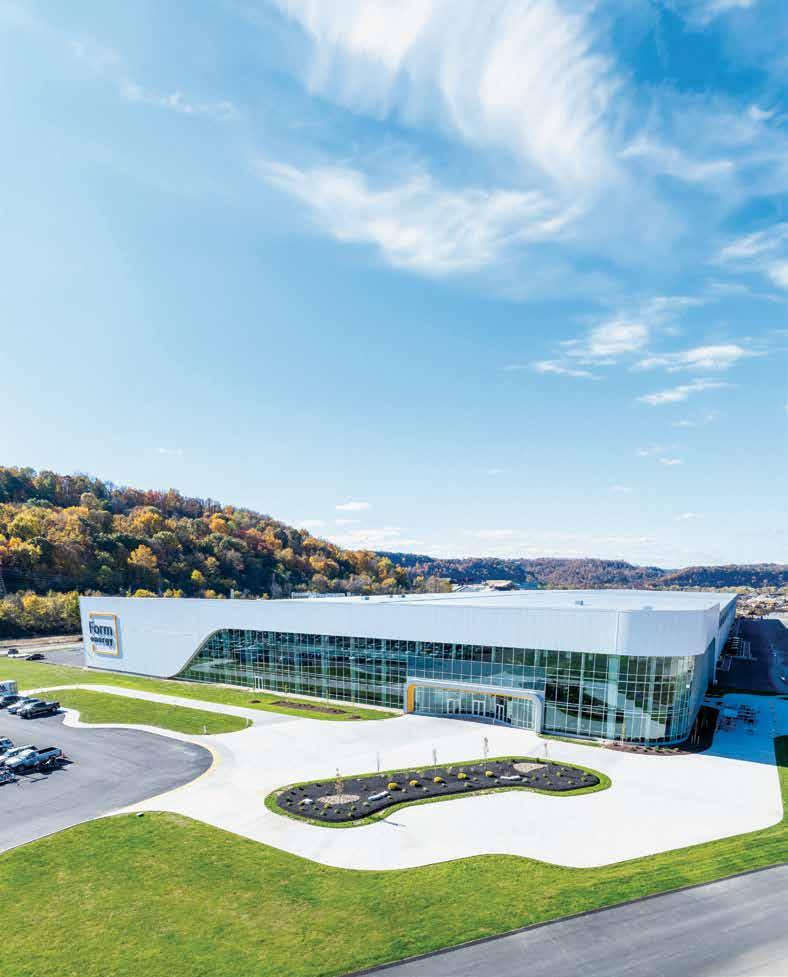
PROJECT PROFILE
FORM ENERGY FACTORY 1
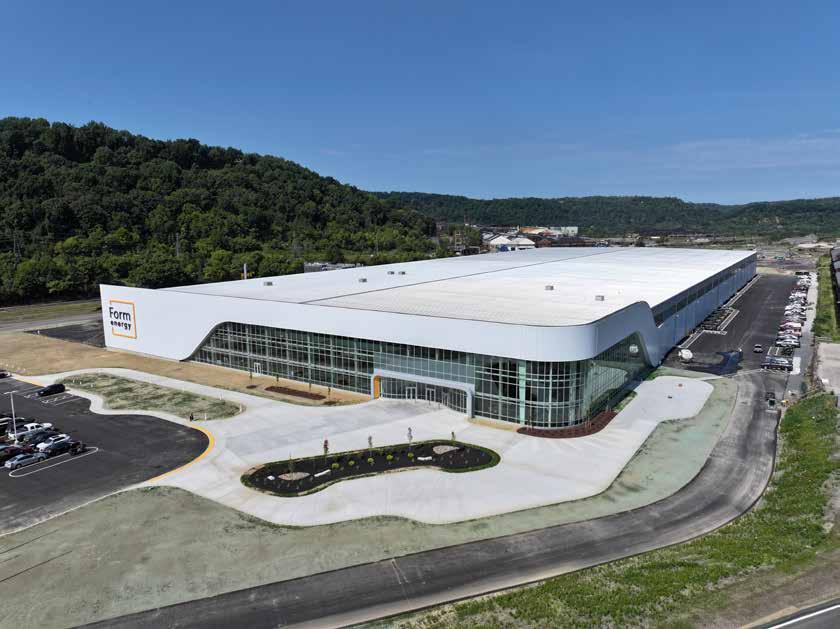
Construction is a linear process. Industry professionals are taught to plan the sequence of a project from beginning to end, so that a superintendent knows on the first day of site work how many workers will be on site on the final day of construction. Such precise sequencing requires extensive planning in advance. Architects and engineers must deliver accurate drawings and specs. Project owners must explain the scope of work completely and communicate expectations thoroughly.
For Massaro Corporation, such thorough planning for the new $150 million Form Energy plant in Weirton, WV, would have been for naught, and would have delivered failure instead of a stateof-the-art battery plant in one year. The Form Factory 1 project succeeded because Massaro and its team of subcontractors and suppliers adapted to what Senior Project Manager Dan Dougherty jokingly called “chaos construction.”
“Soufiane said at the beginning of the project that if we don’t have a substantial amount of rework, we will have failed,” says Dougherty.
Soufiane Halily is Form Energy’s vice president of Form Factory. Before joining Form Energy, he led the design and construction of Tesla’s flagship Giga Texas plant in Austin, TX and was part of the team that developed and scaled Tesla’s battery plants in Nevada, California, and Shanghai. Halily explains that the frantic pace of development in battery manufacturing is the reason why so many of the decisions made in planning and construction of the new plant changed throughout the project.
“Our situation is unique in that we were designing a new class of battery technology. We were developing the product and processes at the same time as we were designing and building a factory,” Hilaly explains. “Because of that everything was in flight. We needed to deliver on an extremely aggressive timeline. If we had to wait until the product was designed and then developed a design and built the factory, it would have gone smoother, but it would have taken five years. We didn’t have five years. We had one year to get into production.”
As was fitting for how the project unfolded, Massaro was selected for the project after a lightning-quick request-for-proposal (RFP)
Photo by Jordan King.
process that was intended for another building. The connection to Form Energy came indirectly, reports Chris Fiumara, vice president of business development at Massaro.
“I got a call from a friend in Washington, PA who told me that Form Energy was doing lots of construction in their building in Eighty-Four, PA. I got a hold of a man named Greg Brewer and got to know him,” Fiumara recalls. “They were doing a number of small projects there but were putting together a design-build RFP to convert the former Weirton Steel Open Hearth Building into Form’s new battery facility. They made a point of saying that this project would go faster than we had ever experienced, and we spent time explaining how we could deliver the project quickly.
“We interviewed with them right before Christmas and I was surprised to get a call at 10:30 that night from Soufiane telling me that we had been selected. But he was also calling to ask if we were ready for a 24-hour, seven-day-a-week project. I had to admit that we had not done a project like that. He said it would be the greatest education of our lives and wanted to make sure we understood what we were getting into.”
“If you have a process like this with a normal construction team they will lose their mind,” Hilaly says. “Massaro showed us that they were willing to take on this culture and dynamism. They were willing to experiment with us on this.”
It did not take long for the dynamism to take hold. Form wanted to have manufacturing begin in the Open Hearth Building within a few months and then develop a new plant for expansion, but when confronted with the costs of the extensive renovation, Hilaly pivoted immediately. The adaptive re-use was cancelled and plans for Form Factory 1 kicked into high gear. For Massaro Corporation, that meant its design-build contract would end. A new architect, Stantec, was hired to design the new building and Massaro was tasked with preconstruction for a 420,000 square foot building that would start within 90 days.
Dougherty says that the biggest challenge of the project may have been the shift in mindset from that point forward. Although Form Factory 1 was being delivered by conventional three-party contractual agreements, it would unfold like a design-build project. His task was to ensure that everyone on the Massaro team, employees and subcontractors alike, embraced that mindset shift.
“We had to accept the fact that moving fast was going to cause some amount of rework. Soufiane said that they were going to go fast and were going to change things on us. The reality is construction was going to be even with or ahead of the design on the project,” Dougherty explains.
“We looked at the timing and the requirements of the client and, even though it was contractually always a design-bid-build, it behaved more like a design-build,” agrees Kate Csontos, principal at Stantec.
By May 2023, the first permit was issued for construction. Hilaly jokes that they got the permit at 3:00 and started excavation at 3:15. While that may have been true, there were still significant decisions to be made, even as site work began.
“We truly didn’t know where all four corners of the building were going to go when we started drilling for the piles,” says Dougherty. “We had an idea of the square footage of the building, but we started in the middle because we did not know how far in either direction we were going to ultimately go. There was a lot of field design and redesign.”
Daily, or hourly, changes in manufacturing design meant that equipment sizing and location were also changing. Something as elementary as the footprint of the building changed even after structural steel was flying. The team adopted a modus operandi that remained throughout the project.
“What we tried to do was to lock the minimum things we needed to lock to continue construction,” says Hilaly. “We made
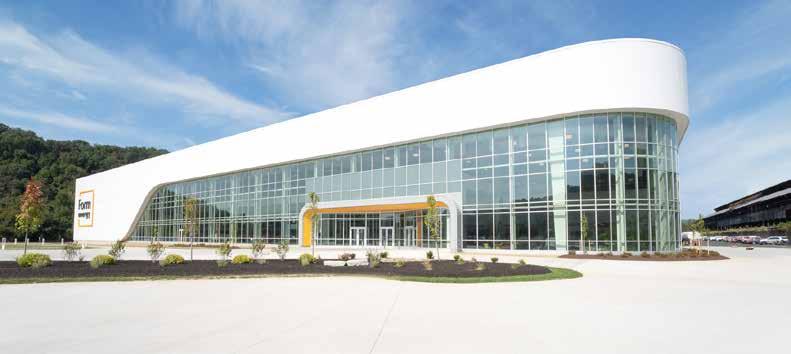
Photo by Jordan King.
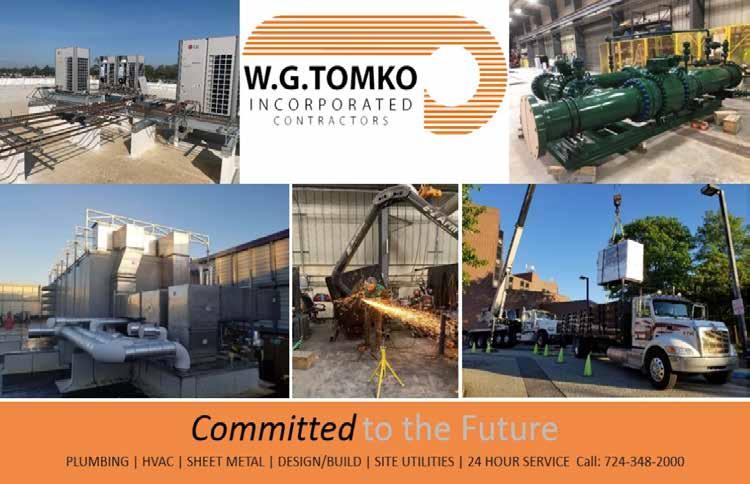
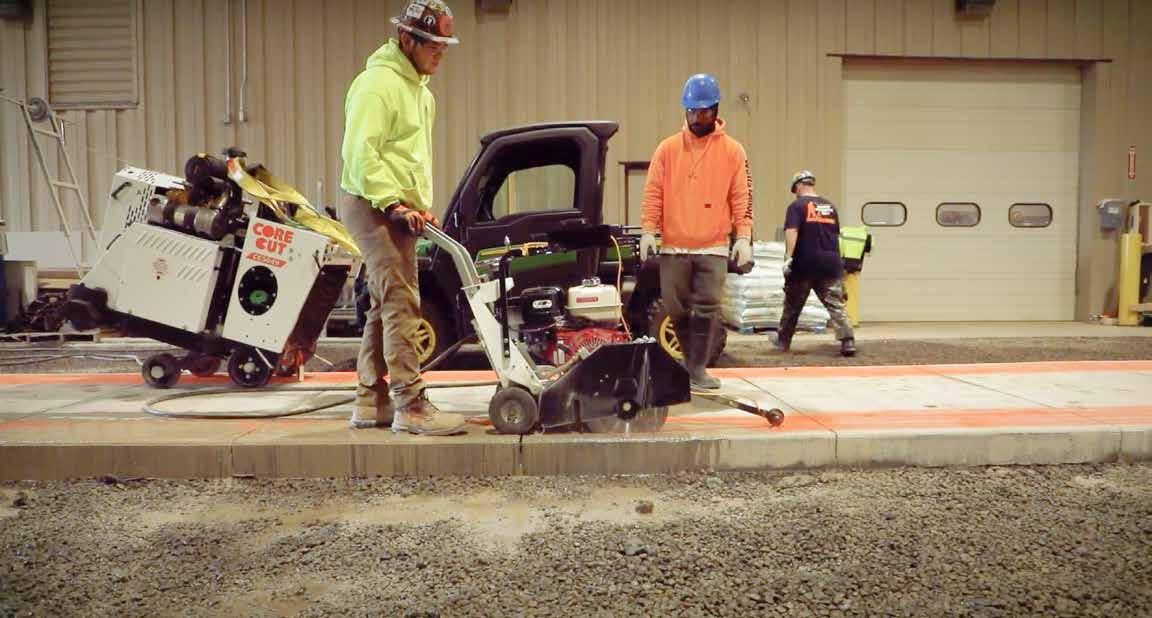


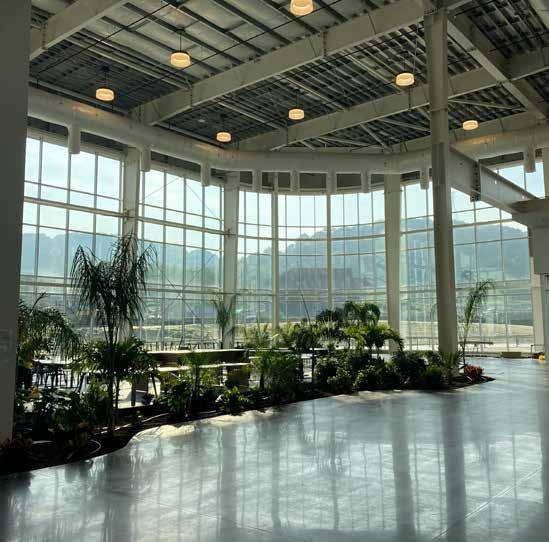
decisions based on our latest test results for the product and manufacturing systems. Sometimes those decisions were at risk. Ninety percent of those decisions were right. But sometimes we were wrong, and we had to correct.”
“We were pre-releasing a structural package for foundations to get them started in the field while we were still formalizing the design beyond the core walls and shell. We could only release anything that we were positive about,” says Csontos.
The start of construction was complicated by the fact that Form had contracted separately with a pre-engineered steel building supplier. That created headaches for Massaro and Stantec, neither of which had a contract with the supplier.
“There was a lot of coordination on our end with the metal building fabricator and Stantec. We had to make sure that Form’s updates were worked into that design, even though we weren’t contractually tied to any of those other firms,” Dougherty says. “We needed to coordinate without having a contractual obligation to do so.”
“It was a challenge having a separate pre-engineered building vendor that was hired by somebody else,” says Csontos. “We
received piecemeal information about what we could finalize. We had to work within somebody else’s parameters while we were trying to create a really cool building.”
Dougherty describes the procurement process as one unlike any other he has managed. As bid packages were prepared, Massaro’s obligation to Form Energy was to take the low bidder, but Dougherty said they made every effort to be transparent about the uncertainty of the process to come.
“We had to tell them it was going to be dynamic. We had to gauge how willing they were going to be to adapt,” he recalls. “On the earliest packages, we did not know the extent to which change was going to occur, but it became more of a discussion point as the project unfolded and we were buying subcontracts. There was no way to fully explain it until they were on board and experienced it.”
Dougherty laughs when asked to give examples of how the team had to adapt, as the changes were constant. There is a litany of highlights.
“The building was a living, breathing thing from day one of construction. Our concrete pour schedule was altered continuously. There were points where we delayed concrete pours or changed pours hours before they were to occur. That just resulted from owner priority changes,” he says. “A 180,000 square foot mezzanine was added to the scope in September 2023. Up to the last few months on site we were still adding to that mezzanine floor.”
“Form was setting up manufacturing equipment and we were still flying steel inside an occupied building. There were operable bathrooms, showers, and locker rooms in one part of the building and 300 feet away the steel wasn’t fully erected. That wasn’t because we were behind schedule. It was because we were bounced around because of Form’s changing priorities,” he continues. “We were finishing drywall, setting tile, and painting in February without the building being fully enclosed. We had a constant crew of up to a dozen people solely working on the temporary enclosures moving heaters around, opening and closing sections of the building as we progressed.”
Such a fluid process rendered the conventional submittal process untenable. Csontos says that Stantec had to adapt its processes to the project.
“I managed the architectural-mechanical-electrical team and the structural team. I kept a deliverable schedule that was alive and changing all the time,” she says. “We worked closely
Photo by Jordan King.
with Massaro and the client on the sequencing to see what happened next and focused our design efforts on that. We tried to hit any long lead items well in advance. We did submittals simultaneously with those pre-release packages while we were finalizing design.”
The extreme challenges caused by the ever-changing scope of work tended to obscure some of the more conventional problems on the project. One of the more daunting challenges was the site itself. Form Energy was being built on a demolished former Weirton Steel manufacturing site, which was located on roughly 30 feet of accumulated subsurface obstructions. These included abandoned vehicles, multiple rail lines (running in opposite directions), truck-sized utility tunnels, and an abundance of waste steel, concrete, and petroleum.
It was the proliferation of subsurface concrete obstructions there were known to exist that helped drive the decision to use micropiles for the foundation. The drilling process for micropiles can penetrate concrete obstructions, although not steel. Form Factory 1 was built on a foundation of nearly 1,000 micropiles, which had an average depth of 145 feet.

Dougherty reports that more than 2,000 tons of steel obstructions were removed, requiring more than 11,000 cubic yards of material to be moved. This included multiple layers of molten steel waste that had to be hammered into pieces and removed by a fleet of heavy excavators. Nearly three-fourths of the piles placed were obstructed by steel.
As might be expected, the pace and dynamism of the project were not for everyone. Dougherty recalls that there were workers who reached their limit on the project and had to be replaced. Csontos says that one of the older members of Stantec’s engineering team asked to be moved off the project. For the most part, however, team members rose to the challenge of Form Factory 1. Dougherty jokes that he made regular use of what he called “the walk” when it was clear someone needed to vent.
“There’s a lot of stress that comes from continuous change. I don’t care who you are, that eventually wears on you,” he says. “I tried to monitor people to judge when somebody needed some fresh air or to step away. We would just take a walk and or go to lunch and just talk about what was bothering them. It took communication and mutual respect to navigate that process. We had to acknowledge the situation we were creating and the challenges it caused.”
Despite the stress and extraordinary working conditions, Form Energy began moving in equipment before spring 2024 and took full occupancy of the building 12 months after construction began. Hilaly believes the strong connections that developed were integral to the success of the project, given the daily uncertainty that characterized the process.
“We developed the design process for the plant at the same time we developed the design process for the product. When you operate in that way you have an extremely deep connection between all the expertise for the product connected to all the expertise for design and construction,” he says.
One of the dangers of a process that is so fluid and accelerated – especially one that is very much driven by the client – is that corners get cut or mistakes are made in attempting to make the client happy. Both Dougherty and Csontos made the point that there were times when it was necessary to dig their heels in to prevent that from occurring. Both emphasized that without the kind of connection that Hilaly described, they would not have been comfortable pushing back with a client.
Photo by Master Builders’ Association.

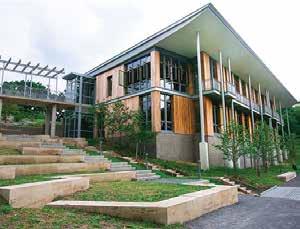

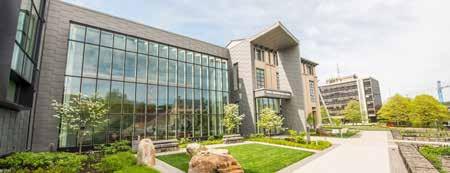
“The teammates were the reason the project worked. All the people involved wanted to succeed,” Csontos says. “I think when everyone wants to succeed, especially in the best interests of the client, you will do anything that’s required of the project. Everybody was nimble and a true partner. That’s probably the only way this could have been successful.”
“Number one, we had extreme focus. There was no decentralized command. The decision makers and the people executing the project were on site six days a week designing and building at the same time,” Hilaly says. “The other factor was that everyone was on board. Everyone on site was committed to succeeding in getting manufacturing open in Weirton in one year.”
“The most important factor in success was mutual respect that existed between Massaro and the owner, the subcontractor teams, the designers, and the City of Weirton. It was a mutual respect that developed between all of those people,” Dougherty says. “We go out of our way on each project to make sure that the people on the job know each other. We want all of foreman to know each other so when a change comes along, there’s already been dialogue and it’s easier to coordinate. For as chaotic as the process was, we had virtually no conflict and I think it’s because we were of a mindset that we were all in it together. We held each other accountable in a good way. Nobody wanted to let any other team member down.” BG
PROJECT TEAM
Massaro Corporation General Contractor
Form Energy Owner
Stantec
Architect/Engineer
Independence Excavating Inc. Excavation
Doran Construction Concrete
Nicholson Construction Deep Foundations
Sure Steel Steel Erection
Maccabee Industrial Inc. Miscellaneous Metals
H.B. Reynolds Inc. Curtain Wall & Storefront
W.G. Tomko Inc. HVAC & Plumbing
Bruce & Merrilees Electric Electrical
LM Construction Interiors
HOFF Enterprises, Inc. Casework
Kalkreuth Roofing & Sheet Metal, Inc. Roofing
Lisanti Painting Company Painting
Schindler Elevator Elevator
Harris Masonry, Inc. Masonry
LEGAL PERSPECTIVE
ENERGIZE YOUR CONSTRUCTION PROJECTS IN 2025
BY JOSHUA R. LORENZ
Spring is in the air! Trust me, it’s there, just breathe in really deeply. Turning the page on winter brings many welcome changes, such as warmer weather, greener grass, leaves on the trees, and everyone’s personal favorite – the advent of another construction season. With new beginnings come new opportunities, and the construction industry is no different. So, what have you done to prepare for the upcoming year since the asphalt plants shut down last fall? Below are some ideas on how contractors, subcontractors, architects, engineers and owners alike can energize their construction projects in 2025 and beyond.
Source More Locally
There are numerous benefits to staying close to home when sourcing your project’s labor, materials and equipment. To begin with, products that are locally sourced have a better chance of avoiding delays and often are easier to obtain, particularly when transit and supply chain issues continue to affect industries everywhere. Additionally, local vendors often are more willing to go the extra mile to ensure your project needs are met in full and on time. The strong prospect of repeat business from a local customer as opposed to a oneoff engagement with a customer halfway across the country (or even overseas) could mean the difference between your order being manufactured and supplied in a timely fashion versus being moved to the back of the priority line. Further, for projects with formal or informal sustainability goals, including LEED certification, local sourcing of labor, materials and equipment can be an effective means towards such ends. While this is not always possible and may not be the least expensive option, sourcing more locally could avoid costly headaches down the road and improve the success of your project.
Develop Contingency Plans in Advance
Think back to your recent projects. How many “Plan B’s” were enacted over the last few years? How many “Plan C’s” became necessary when your first two options didn’t come through? More than ever, anyone involved in the construction industry must have contingencies in the event that a project or a portion of a project unexpectedly heads sideways – or even backwards. Moreover, it is imperative that these plans be in place early in the process. When a supplier tells you mid-project that it will not be able to meet a delivery deadline, that should not be the first time you are exploring other potential options in terms of alternate suppliers or materials. If an item is critical to your project, at a minimum you should research where else it can be obtained if an issue with your preferred supplier or material arises. Likewise, have related conversations with everyone involved on the project so if a pivot becomes necessary, no one is caught off guard
and everyone is on board. In the context of a supply issue, contingencies might include using a different supplier, utilizing a different product, or altering the project schedule to align with the delay. Again, having these discussions with all interested parties early on in the process – before any problems arise – is key to developing workable contingencies.
Implement Appropriate Mechanics’ Lien Practices and Procedures
So far in 2025, there has been a noticeable uptick in mechanics’ lien claims being threatened and/or filed, both in Allegheny County and surrounding counties. There are multiple reasons for this increase, but regardless of the causes, construction industry professionals must understand Pennsylvania’s Mechanics’ Lien Law (“MLL”) and plan ahead if they are to successfully file or defend against a mechanics’ lien claim(s). Since the landmark changes to Pennsylvania’s MLL that went into effect in 2007 – most notably the elimination of the blanket pre-construction mechanics’ lien waiver that had been utilized on virtually every commercial project – additional, significant revisions have been enacted. These include the creation in late 2016 of Pennsylvania’s State Construction Notices Directory, which can be utilized on projects totaling $1,500,000 or more, and the accompanying notice and filing requirements relative to mechanics’ lien claims.
Despite these groundbreaking changes to Pennsylvania’s MLL and companion court decisions, many do not understand the resulting implications to the construction industry and, therefore, have not made the corresponding necessary changes to their business practices. For example, have your contract provisions regarding mechanics’ liens been reviewed and updated recently? What about your interim and final mechanics’ lien waivers? Is the project a “searchable project” registered with the State Construction Notices Directory and, if so, are you complying with any notice and/or filing requirements? For projects where advanced lien waivers are permitted, has a “no lien agreement” been executed? Has the “no lien agreement” been filed and appropriately indexed with the court in the county in which the project is located prior to work commencing? All the above could have drastic implications on your ability to file or defend against mechanics’ lien claims. If you have not taken the time to understand Pennsylvania’s MLL and to implement appropriate steps to ensure that your business complies, you may be at a significant disadvantage if a dispute arises.
Attention to Cybersecurity is a Must
Stemming from the increased use of virtual project folders, the proliferation of building information modeling (“BIM”), and the ever-increasing amount of work in the construction industry being performed in an online environment,
cybersecurity never has been more important. Cybercriminals and bad actors are ubiquitous today, and they don’t discriminate or play favorites. If your business has access to information or finances – and those in the construction industry fit both profiles – you are a potential target. Indeed, almost 6 in 10 businesses suffered a ransomware attack in 2024, which actually is slightly down from the previous two
Your Right Size Law Firm
years. And though businesses are targeted worldwide, North America receives the largest proportion of industrial ransomware attacks, accounting for roughly 43% of the global total.

The seizing of information can be catastrophic to construction industry professionals. Data that is stolen can be sold and disseminated on the dark web. Computer systems, software programs, bank accounts and the like can be held hostage, altered, or emptied. Such scenarios can and do happen, and they can bring your business, and any projects on which you are working, to a screeching halt. Consider, too, a possible scenario in which a general contractor constructing a new bank branch or an addition to a hospital utilizing BIM were to have personal information, including passwords, stolen by a hacker after someone unknowingly opens a “phishing” email. Suddenly, that cybercriminal has access to alter the BIM in harmful ways or to obtain significant knowledge about the building, which could be used for nefarious purposes.
Effective cybersecurity today must be about more than firewall protection and virusscanning software. For organizations with access to sensitive information, including that of their clients and colleagues working with them on a project, more advanced strategies are required. The National Institute of Standards and Technology’s (“NIST”) Cybersecurity Framework was designed for federal agencies, but U.S. businesses also are encouraged to use it as a guide for their own cybersecurity plans. Those in the construction industry must work with qualified internet technology professionals in order to safeguard their information as best possible.
Revisit Insurance Coverages and Policy Limits
In the wake of the global pandemic, insurance has become even more important in the construction industry. Those events and the aftermath may have exposed gaps or weaknesses in insurance coverages, leading many to take a closer look. However, this should be an ongoing process as part of your overall risk management strategy. Time and experience should serve as guides about the types of coverage and appropriate policy limits that may be necessary going forward. It is important, however, to obtain the right insurance products that meet your company’s particular needs; not all insurance is created equal. Does your current coverage encompass the types of claims you are facing? Is cyber insurance needed? Are your policy
limits sufficient given the size and volume of the projects in which you are involved? Are you satisfied with the Builders Risk insurance being used on past/current projects? Planning for potential problems and asking the right questions in advance of selecting coverages and policy limits are critical to an effective insurance program.
Contracts are Critical to Project Success
Finally, and perhaps most importantly, construction industry professionals should regularly review and revise their contract documents. Laws change, regulations change, and aspects of the construction industry change. In turn, your construction contracts also need to change and evolve over time. The subcontract agreement that may have worked very well when it was originally drafted years ago now may be inadequate, outdated – or even illegal. Contracts form the backbone to every project. They define roles, set forth the scope of work, define payment terms, outline dispute resolution procedures, and essentially address everything else governing the parties’ relationships on the project. In short, your contracts play a major role in how successful a project will be for its participants. Some items to review (and perhaps improve upon) in your contracts include:
• Supply chain interruptions
• Force majeure
• Indemnification
• Liquidated damages
• Damages for delay
• Jurisdiction and venue (choice of law)
• Substitution of materials/systems
• Price escalations
• Retainage
• Shared savings
• Insurance/Bonding (including Builders Risk and payment/ performance bonds)
• Notice
• Dispute resolution
As we enter what everyone hopes is a safe and productive construction season, taking a closer look at the aspects of your construction business identified above and making any appropriate changes can maximize your success for 2025. BG
Joshua Lorenz is a partner at Pittsburgh-based law firm Meyer, Unkovic & Scott and is general counsel and co-chair of the firm’s Construction Group. He can be reached at (412) 456-2836 or jrl@muslaw.com.

IN A WORLD WHERE RESILIENCY IS NEEDED MORE THAN EVER,
In the face of increasing complexity, our approach is simple: hire the best people and invest extensively in the industries and clients we serve. We operate through one national platform, so clients have access to our resources and expertise – regardless of where the resource is located – to capitalize on new opportunities to grow and protect their organizations.






visit www.schneiderdowns.com/construction

FINANCIAL PERSPECTIVE
SURETY MARKET UPDATE
The surety industry, which indemnifies much of the construction that occurs against performance and payment default, experienced another solid year in 2024. Marked by strong premium growth, the surety market also saw a continuation in the post-pandemic trend of higher losses. The largest insurers had the strongest performance but saw a slight increase in major loss activity. These trends that suggest an erosion in the market are expected to cause some tighter conditions for bonding; however, industry veterans agree that conditions are far from those present in a hard market.
Insurers saw 6.8 percent growth from 2023 to 2024, an annual growth rate that is expected to continue through 2028. This growth rate, along with the continued addition of insurers coming into the market, suggests that there will be ample capacity for contractors to maintain or grow their bonding in 2025.
“We are not in a hard market,” says Steve Squelgia, vice president-bond manager for First National Insurance Agency. “If a company is taking care of their balance sheet, their financial statement, they are completing their jobs, and their work is in good shape, they are probably comfortable with their surety relationship.”
“The trends in the industry are interesting. From the end of 2022, the business went from a direct loss ratio of 14.9 percent, last year finishing around 22, and through nine months of 2024 looking at 25 percent. That doesn’t look like a good trend, but when you dig deeper a lot of the losses in 2024 weren’t from construction projects,” says Will Chapman, senior vice president and head of surety at Seubert and Associates. “There were some big losses in the oil and gas space that were unrelated to construction. Contract surety is still performing quite well. We are seeing a little bit of tightening but it’s still a market where the client and the customer can get what they want.”
Jim Bly, managing director for Alliant Construction Services Group, explains that the direct loss ratio is not as indicative of the health of the market as it may be in other years. Aside from the predominance of larger individual project defaults, Bly notes that there is some bifurcation in performance between the biggest surety companies and the rest of the industry.
“If you look at the industry results, seven of the top 25 were in a loss position or marginally profitable. Because of the expense ratio, the benchmark for profitability in surety is a 40 percent loss ratio. Seven of the top 25 were 40 percent or higher, which is a little more than the normal three or four,” Bly says. “But only one of the 10 largest had a loss ratio of 40 percent. The big insurers are doing well. Six of the next 15 sureties were potentially losing. That means the reinsurers that prop up that next level of capacity could tighten standards for smaller programs.”
Bly says that there were cases where individual insurance
companies have reacted to problems by withdrawing from the market or parts of the market, but additional capacity has replaced any that was lost. Bly also pointed to a trend that he says contributed to losses more in 2024 than in previous years.
“More of the losses have been coming from ownership transition and the financing related to ownership transition. The new owners are more leveraged. We’re seeing that in subcontractors’ pre-qualification that we do across the country,” he says. “Private equity deals are creating debt that have led to default losses. We’re seeing an uptick in subcontractor defaults of significant sizes. We only have eight subcontractors having losses in our portfolio of thousands but those have losses between $3 million and $10 million, which is more than we’ve seen in losses combined in the past few years.”
Alliant maintains a database of thousands of specialty contractors nationwide, tracking key financial and performance indicators on 2,500 firms (250 regionally) that it uses to produce its Contractor Credit Model (branded as C2M™). Andrew Bly, vice president at Alliant, analyzes the data and says the various concerns about the market have had less impact on subcontractors.
“We haven’t done our final 2024 subcontractor benchmarking review but overall, the subs are performing pretty well. Their C2M scores are above the level that we would be concerned about,” he says. “In 2023, scores dropped compared to 2019, but I expect them to go up a little in 2024. There are problems in some pockets like Florida, Washington DC, California, and Colorado, but the Pittsburgh market is doing very well. I’ve only seen red ink on one client in Pittsburgh.”
Mike Kapics, principal and national director of construction solutions for HBK CPA’s and Consultants, works with general and specialty contractors regionally and nationally. He says HBK has seen some slight deterioration in certain aspects of performance, while noting that construction activity overall is still strong, especially for subcontractors. Kapics says fewer of his contractor clients are struggling with finding an adequate workforce than in recent years, but that there is more pressure on cash flow.
“For general contractors, cash flow has become more of an issue as it seems like they are experiencing slower payments from owners,” Kapics observes. “Backlogs for specialty contractors are still very strong. There is lots of competition on the government/public work but private work, especially manufacturing, seems to be holding on for now. Almost all of my clients are getting paid more slowly.”
Surety professionals anticipated performance issues in 2022 and 2023 because of the pandemic. Historically, surety losses follow two or three years after a major economic event or recession. Pandemic-related aid, primarily the Paycheck Protection Program, helped contractors ride out the financial hiccups
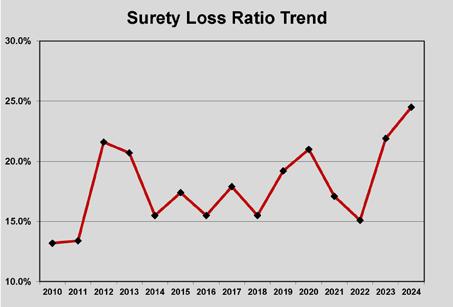
Source: Surety and Fidelity Association of America.
caused by supply chain disruptions, labor shortages, and hyper escalation. With higher interest rates, tighter credit, and more restrictive bank covenants, 2024 offered more challenges unrelated to construction; however, the construction industry saw working conditions return close to pre-pandemic norms.
and stabilization in material prices and inflation. There were more collaborative processes between owners, architects, and contractors as well,” says Chapman. “We’re expecting much the same in 2025.”
Most surety professionals expect 2025 to be similar to the past few years, although most see some slight tightening of conditions. If that proves to be true, there will be more opportunities for surety providers that are newer to the market and for unconventional surety products. Squelgia notes that the credit surety market, which underwrites risk based upon the personal credit of the principal instead of the business, is seeing an uptick.
“A contractor with a decent credit record and a good personal credit score can probably get a bond up to a million dollars based upon their personal credit,” Squelgia says. “They are not providing corporate financial statements or CPA-verified statements.
They’re being underwritten on their personal credit. Those are great programs for a business that doesn’t want to spend $15,000 to have a CPA prepare a review or an audited statement.”
“In 2024, we saw greater predictability in the supply chain
Squelgia notes that the carriers for that type of program are charging rates of three percent, while an established Losses from defaults rose again slightly in 2024.



For over 120 years Local 66 in partnership with our Contractors, have been committed to provide qualified and competent Operating Engineers. The most successful companies are union signatories. We will help you to remain competitive and to gain the marketplace advantage. You will keep your employees and we will work with you to provide skilled training; and as you grow and your needs expand, we can provide you with a qualified workforce. This partnership is a positive approach to doing business. Your company must remain competitive during all economic conditions. We bring positive factors to the relationship – training, reliable workforce, safety, quality and a stronger community presence.
“We partnered with the Local 66 in 2011. Since then, we’ve been able to take on many more clients, more difficult work, due to the contribution of their great staff.”
J.J. Stefanik - President Stefanik’s Next Generation Contracting Co.
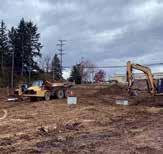


”Mascaro Construction Company is a regional general contractor that’s been around for 33 years. Proud to say that 30 of those years, we’ve had a relationship with the Operating Engineers providing us with skilled craftspeople that run all the equipment that we have.”
John C. Mascaro Jr. - President Mascaro Construction

“Working
contractor with a good balance sheet and audited financial statements may pay half a percent. The higher premium is offset by the lower professional costs and the simpler approach to the program.
“They don’t need bonds for multi-million-dollar projects,” Squelgia says. “There are lots of companies that want to write that kind of business with very little underwriting at a three percent rate. And honestly, I’m not seeing many claims in that part of the market.”
The coming year will not be without challenges. Andrew Bly notes that insurers are dragging out the requests for programs for 2025, even for established contractor clients. He also observes that claims for late payments from the owner or lender have been on the rise. The biggest uncertainty facing the surety agents seems to be coming not from the construction market, but from the policies that may come from the new administration.
“Obviously government policies can change the market. Anytime you have sudden changes in economic or political policy, it can create some disruption. That’s certainly on the mind of many underwriters right now,” says Chapman. “Changes in labor and immigration policy are things that would affect the construction industry more than others.”
“Tariffs, like the ones recently announced on steel and aluminum, are something to be concerned about because of the impact on prices. We experienced that during the

pandemic when lumber prices spiked. Contractors were locked into bids that were well below the price of lumber when they went to buy it, which hurt their margins,” Jim Bly recalls. “We are also concerned about the impact of deportation on the construction workforce.”
Bly also expresses caution about potential problems within the surety industry that are unrelated to construction activity. With the insurance industry overall struggling to manage losses from the past two years’ natural disasters, growing losses in surety bonds could cause companies to leave the market, as they did in 2004. Coming on the heels of multiple years of catastrophic property and casualty losses, the 100 largest insurers experienced surety losses of 60 percent in 2004 and 40 percent in 2005. Five of the top 20 surety carriers exited the market, creating a capacity crisis that left many contractors with reduced or no bonding. Bly is confident that the industry will not see those kinds of losses again but notes that there are factors beyond construction surety that could trigger a hard market.
“The slippage in underwriting results is surely worth noting. If these loss trends continue to a greater degree, it could have a material impact on the market,” he says. “We are seeing it in some of the hotter markets because the project sizes are very large; the risk profile is there; interest rates are higher; and the underwriting standards are a little tougher on bank credit. There are just more things in play that can cause a default.”
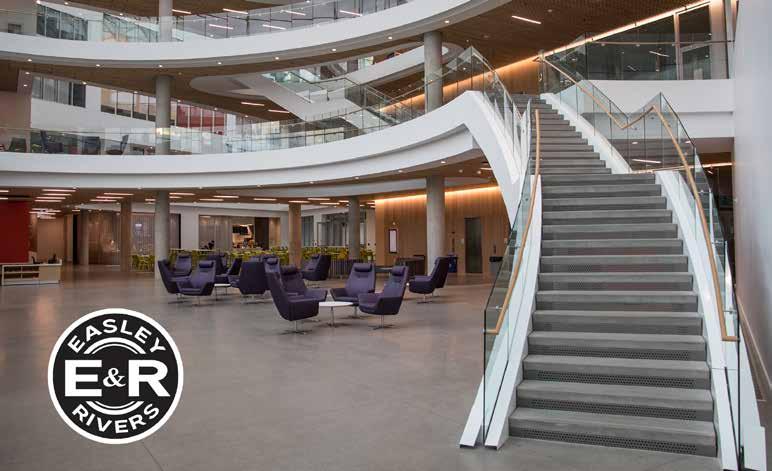
TREND TO WATCH
HOW PRIVATE EQUITY CAN CAPITALIZE ON ELECTRIFICATION: TRENDS IN THE BUILT ENVIRONMENT
BY PAUL GIOVANNONI AND ANDREW HENDERSON
The electric power space continues to evolve as demand increases (largely driven by technology and manufacturing), generation moves to renewable energy sources and transportation increasingly uses electric power. Investment opportunities span a wide spectrum — from supply to demand and utility scale to behind the meter — across which there are thousands of lower-middle-market firms operating.
On the generation side, renewable energy, including solar, wind and hydropower, continues to expand rapidly. In 2023, renewable energy sources accounted for approximately 25.7 percent of the net electricity generation in the U.S. This marks a significant increase from 7.8 percent in 2001. During the same period, coal’s contribution to electricity generation declined from 51 percent to 15 percent.
This increase in alternative sources, along with growth in traditional fossil fuel generation in the U.S., is pushing electric outputs higher. Natural disasters have also led to an increased focus on distributed energy resources, microgrids and the resiliency these solutions can provide. Rekindled interest in nuclear and a potential energy-first agenda from the incoming administration are expected to spur growth in electric generation and the firms that serve this portion of the market.
At the other end of the spectrum, demand for electricity isn’t slowing. U.S. electricity consumption is expected to increase by as much as 15 percent by 2025, according to the U.S. Energy Information Administration. The rise of data centers, semiconductor manufacturing in the U.S. and electricity demand within buildings requires expansion and modernizing of the electricity grid to keep up with these power-intensive industries. This extends within the building as well, including controls, automation and a greater densification of electrical infrastructure. Around 80 percent of buildings in cities today will still be standing in 2050. That aging infrastructure continues to be a core driver of electrification solutions in facilities.
some of the trends in electric power and how smart investors can take advantage of the momentum.
ELECTRIFICATION TRENDS CREATE OPPORTUNITIES
When it comes to opportunities in the electric power space, there are several themes that investors should consider.
At the other end of the spectrum, demand for electricity isn’t slowing. U.S. electricity consumption is expected to increase by as much as 15 percent by 2025, according to the U.S. Energy Information Administration.
TREND 1: REDUCING CONSUMPTION AND IMPROVING ENERGY EFFICIENCY
While most every aspect of the U.S. economy is increasing power demand, approximately two-thirds (61 percent) of total electric power consumption in the U.S. can be attributed to the industrial and commercial sectors, indicating that heavy machinery, manufacturing and powering commercial buildings significantly contribute to total electricity usage. Many owners in the commercial and industrial sectors are working to reduce consumption and upgrade electric infrastructure to meet clean energy goals and cut costs.
Heating, ventilation and air conditioning (HVAC) systems, components and lighting consume nearly 80 percent of a commercial or industrial building’s power. Electrical service providers with expertise in controls and building management systems can help building owners optimize these systems, leading to reduced costs and lower energy consumption.
TREND 2: GROWING GOVERNMENT INVESTMENT
State and federal government investment in and incentives for clean energy, grid resiliency, energy-efficient buildings and advanced manufacturing are strategically designed to accelerate the transition to a lower-carbon economy while meeting demand needs and supporting sustainable infra- structure development.
In a sector that is highly fragmented and primed for professionalization, investors willing to grasp the nuances of varying geographies and markets will find ample opportunities to invest and create value. Here we explore
The Inflation Reduction Act (IRA) allocated $161 billion in clean electricity tax credits, $36 billion to clean fuel and vehicle tax credits, and $35 billion to conservation efforts. And the Infrastructure Investment and Jobs Act (IIJA) provides the largest infrastructure and economy investment in U.S. history, with more than $1.2 trillion in spending through 2026.
Of the total funding, approximately $73 billion will go to power infrastructure and grids. While these funds have already been allocated, the incoming administration could put restrictions on spending. It is unlikely that funding will be retracted since this would require congressional action and the discontinuation of projects that have economic benefits for many states.
Complementing these federal initiatives, many states have launched ambitious electrification programs, including direct funding, utility incentives and progressive energy mandates, aimed at accelerating deployment at the local level. Furthermore, state-specific policies and programs have added billions more to these initiatives, emphasizing regional priorities and driving innovation tailored to local conditions. These short-term funding allocations have longterm implications for the electrical installed base of electricity and will spur more demand for services for decades.
Understanding how these dollars will be allocated can help investors make strategic decisions about the locations and types of companies they pursue. There are also tax deductions and other incentives intended to drive investment and speed up the shift to cleaner energy.
TREND 3: IMPROVING THE ELECTRICAL GRID
The Building a Better Grid initiative enables more than $13 billion in federal funding to be directed toward the modernization of the electrical grid network. This comes at a time when experts in the U.S. estimate that the network will need to grow 60 percent by 2030 and triple by 2050 to accommodate the rapid changes within the energy sector.
Upgrading transmission and distribution infrastructure is essential to meet the growing demand and to seamlessly integrate higher amounts of renewable energy into the grid. Strategic investments in smart grids, energy storage and grid flexibility allow electrical providers to effectively address the evolving requirements of electrification, support clean energy initiatives and achieve emissions reduction targets while ensuring reliable and sustainable power supplies.
Because transmission and distribution lines already carry substantial energy loads and substations are often located on the outskirts of urbanized areas, there is clear need to prioritize upgrades, maintenance and restoration work on the electrical infrastructure. The lack of capital and necessary labor force coupled with the extensive timelines for major transmission projects further emphasizes the

need to efficiently and intelligently expand the grid. Power system engineering providers and software solutions sit at the forefront of this massive development effort.
TREND 4: SHIFTS IN DEMAND FROM DATA CENTERS AND MANUFACTURING
The rise of artificial intelligence (AI) and the data centers and other technological infrastructure needed to support it continues to be a major driver within the electricity sector. New data center space totaling more than 21 million square feet is being developed in the 10 largest U.S. zip codes, with northern Virginia leading with 1,900 megawatts of capacity.
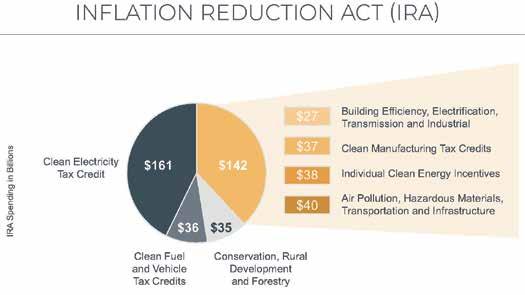
Roughly $375 million in tax credits and other incentives are part of the Inflation Reduction Act spending. Source: FMI Analysis, U.S. Government, Energy.gov
The typical data center requires about 1,000 kilo- watt hours per square meter per year to operate, mostly due to cooling systems and server demand. As more data centers come online, the energy needs continue to compound, necessitating more efficient power distribution, better reliability and a greater abundance of distributed energy resource options.
But it’s not just data centers driving the increase in consumption. The surge in industrial facility construction directly ties into the broader trend of electrification, particularly in semiconductor manufacturing. As firms like Samsung, Micron and Taiwan Semiconductor Manufacturing Company commit to building new plants, the demand for advanced electrical infrastructure — such as transmission and distribution lines and substations — skyrockets. Manufacturing-related construction has grown more than 300 percent since 2020, and these electric-intensive buildings will require maintenance and upgrades to remain viable.
This shift not only supports the electrification of manufacturing processes but also stimulates local economies through the need for extensive electrical upgrades and technology services. These advancements are crucial for the industrial manufacturing sector, as they enable more efficient and sustainable production practices. Furthermore, situating these facilities outside major metropolitan areas increases the need for regional electrical infrastructure improvements, which can drive local development and strengthen resiliency in communities.
Buildings across various sectors are increasingly adopting electrification initiatives to boost energy efficiency and sustainability. Facilities are transitioning to electric HVAC
systems and advanced LED lighting with smart controls and integrating renewable energy sources like solar panels. They are also installing electric vehicle charging stations and employing smart technologies and energy storage solutions to improve management. In more specialized applications like health care and manufacturing, innovative electrified solutions are coming to market to reduce the environmental impact and improve operational efficiency.
WAYS TO LEVERAGE THESE THEMES
Across the spectrum, the electricity space is ripe for consolidation since it is highly fragmented with a diverse array of solutions and providers. Value creation opportunities are plentiful as most firms serving this broad landscape are often founder-led and lack the resources to grow with the expanding market. Investors can target geographic expansion or consolidation, service/ product line growth and high-quality talent acquisitions.
Electrical service firms. These firms are the front- line providers across the entire spectrum and range from utilityfocused providers dedicated to the electrical grid to service firms operating within facilities. These labor-intensive firms are in high demand as infrastructure becomes more complex and the need for services outpaces labor supply. The result for many firms has been increased margins and a greater ability to compete on value instead of price. This increased demand has also paved the way for smaller firms to move upmarket and accelerate their growth.
Product and equipment distribution. Firms serving this slice of the market are the key connection point between equipment manufacturing and installation, offering a wide range of opportunities to capitalize on the macro trends without having exposure to labor or installation. Firms within this category are diverse and can be focused on highly engineered systems, more commoditized products or somewhere in between. Often these firms specialize
in one portion of the electrical market continuum (e.g., generation, grid) and have a unique go-to-market approach that caters to it.
Equipment Manufacturers. The broader supply chain for construction-related materials has largely returned to prepandemic conditions except within the electrical market. The significant demand generated from larger utilities, data centers and the manufacturing sector have filled the backlogs for major original equipment manufacturers
(OEMs), thus creating long lead times that threaten project schedules. This has created significant growth opportunities for lower-middle-market electrical manufacturers that can provide an alternative to the large OEMs, often offering a customized solution with better lead times and improved customer service. These manufacturers make products ranging from transformers to switchgear and controls, to commodity products and everything in between.
CAPITALIZING ON OPPORTUNITIES


For private equity investors seeking opportunities in the built environment, the electric space offers many ways to deploy capital. Those seeking quicker turnarounds can consider vertical or horizontal integrations of companies and service providers to create value at scale.
Others — those who may desire longerterm investments — can take advantage of evolving demand and how electricity is provided to invest in new technology providers and means of generation.
Investors need detailed information to make decisions that are right for their strategies. Understanding relevant trends and their long-term effects on the electricity space, including the nuances of where these companies operate, how they connect to the electrical market and where they provide value, can help you craft strategic consolidation plans or determine how best to add value. BG
Paul Giovannoni is a partner at FMI. He partners with private equity firms to help develop strategic insights into businesses and market opportunities within the built environment. He can be reached at Paul.Giovannoni@fmicorp.com. Andrew Henderson is a managing director in the Energy Transition practice. He can be reached at Andrew.Henderson@fmicorp. com.
Editor’s note: Reprinted with permission from FMI. The full white paper can be viewed at https://fmicorp.com/insights/ industry-insights/how-private-equity-cancapitalize-on-electrification-trends-in-thebuilt-environment.

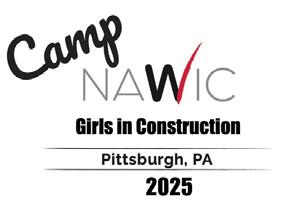


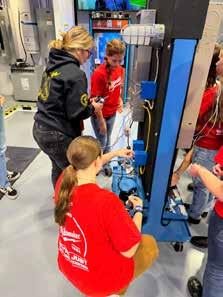
2024 Partnering Union Apprenticeships:
Electricians (IBEW Local 5)
Carpenters (EAS Carpenters Local 432)
Operating Engineers (IUOE Local 66)
Bricklayers (BAC Local 9)
Ironworkers (IW Local 3)
Get a hands-on introduction to the construction trades -- hand tool basics, jobsite tours, building, climbing, technology, construction safety, and more!
Learn from women in a variety of construction professions with apprenticeship, college, and non-college backgrounds!
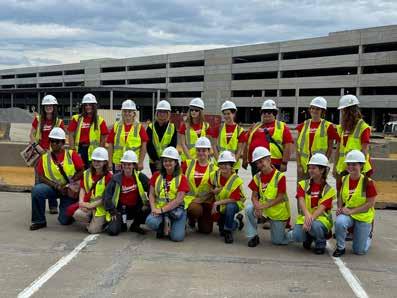


Continuing to Build the Future with Honesty,










•Carnegie Mellon Forbes&Beeler Hall – Mosites
•DelFrisco’s DoubleEagleSteakhouse – A. Martini &Co.
Smallman, Aurora Fit-Out – PJ Dick Inc.
•GroveCity College Buhl Library – Landau Building Co.
•DuquesneUniversity
RAM Acoustical
RAM Acoustical Corporation is proud to play an important in the region’s economy byemploying a professional Union work force generating millions of dollars inwages, pensions, health benefits, and state/local taxes.
RAM also participates in a multitude of community projects.



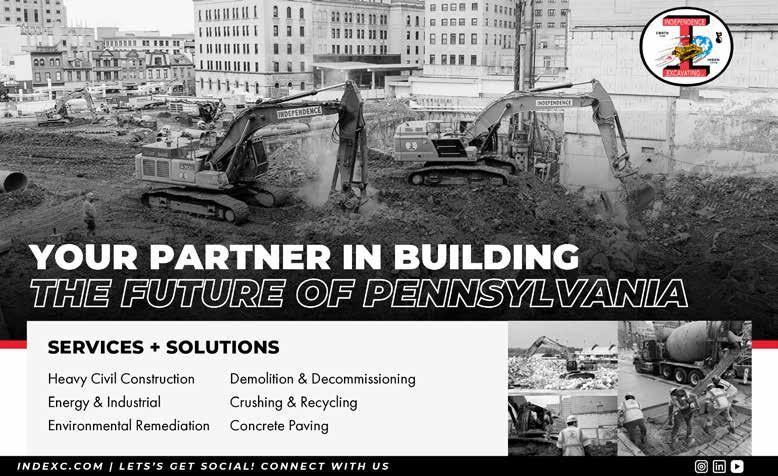
INDUSTRY & COMMUNITY NEWS




Master
(MICA)
Interior Contractor Association
Scholarship winners are (from left) Christopher McCambridge, Kyle Jancsar, Michael Zayzus. Wyatt’s Fred Episcopo, MICA vice president, is on the right.
(From left) John Paul Busse from F.J. Busse Co., Dave Hengelsberg from Uhl Construction, and PJ Dick’s Eric Pascucci at the MBA Annual Membership Meeting on January 17.
TEDCO’s James Frantz presents the 2024 Penn State Department of Architectural Engineering Scholarship to Kiera Harger.
Mascaro’s Rick Bowers presents the MBA/CAP 2024 Safety Scholarship to Bethany Matlos, a senior studying safety management at Slippery Rock University.
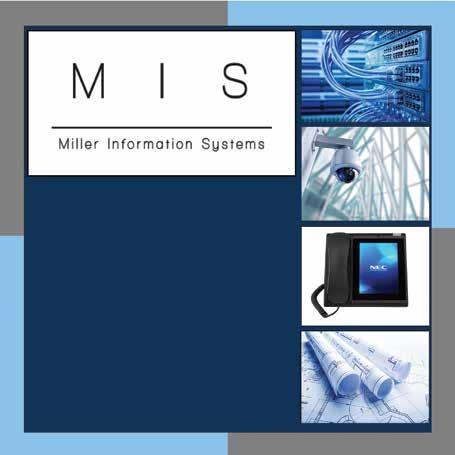




(From left) Tineke Reali from Wildman Chambers Group, Mascaro’s Alyssa Kunselman, CannonDesign’s Sophia Ogiso, and Turner’s Megan Corrie. Photo by Chad Isaiah Studios.
Dollar Bank’s Steve McCarron and Karen Kukish from the Tall Timber Group. Photo by Chad Isaiah Studios.
Susie Slater from PJ Dick (left) with Langan Engineering’s Nicole Rice, CREW Pittsburgh 2025 president, at the CREW Holiday Party on January 9. Photo by Chad Isaiah Studios.

(From left) Miranda Anderson from Atlantic Engineering, Massaro’s Anthony Didiano, and Melissa Davis from Providence Engineering at the January 31 NAIOP Ski Outing.



The 2025 Gentlemen’s Night Out on the North Shore was held on Friday, February 21, in the PNC Champions Club at ACRISURE Stadium. The event, which benefits the National Aviary, was hosted by Michael Mascaro, the executive vice president of Mascaro Construction and a member of the National Aviary Board of Trustees. The evening raised a record-breaking $222,000 in support of the National Aviary’s work to save birds and protect their habitats. Pictured are Michael Mascaro, Cheryl Tracy, executive director of the National Aviary, and Mike the Owl (left).



(From left) Miranda Anderson, Reid Cservak from Rycon Construction, TEDCO’s Kyra Sarver, and Elli Fry from the MBA.
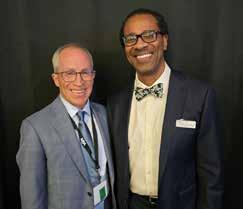

Todd Dominick, retired CEO of Rycon Construction, (left) was recognized as the Jim Kling Fellowship Award winner by the AIA-MBA Joint Committee at the MBA’s Evening of Excellence on February 27. The MBA’s Lance Harrell is on the right.

Bob
from the MBA, Don Ohler from Rocky Bleier Construction Group, the MBA Safety Champion, and Anne Osbourn, industry segment manager from MSA. Photo by
Professional

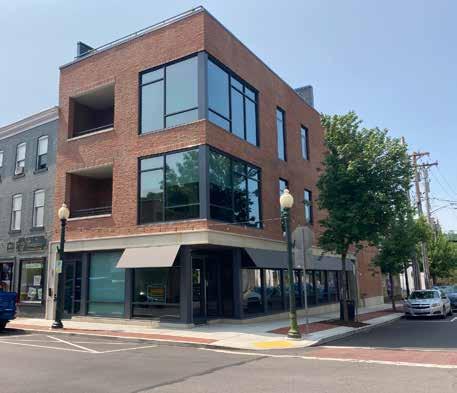


(From left)
McCall
Kaitlin Brinser, Mediaquest.
(From left) PJ Dick’s Jake Ploeger, MBA Safety
of the Year Joe Franceschini, and Rick Scott. Photo by Kaitlin Brinser, Mediaquest.
(From left) Ray Neil Jones and Donald Jones from Jones Maintenance Contractor, and Layne Estle from Black Diamond Equipment Rental.
Photo by Kaitlin Brinser, Mediaquest.


Geri and Joe Leahey from McCrossin.
by Kaitlin Brinser, Mediaquest.

PSI, and Bristol Environmental’s
Jeffrey Knoche and Kevin Thomas. Photo by Kaitlin


Photo
Emily Landerman from A. Martini & Co., with Eric Booth from Desmone Architects.
(From left) Doug Finke from Intertek
Brinser, Mediaquest.
(From left) Lauren Pataky from Armstrong World Industries, Kate Schuster from V.O. George, and Burchick’s Dave Meuschke. Photo by Kaitlin Brinser, Mediaquest.






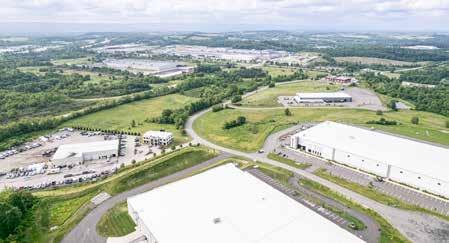



(From left) Sheena Sundin from DRAW Collective, Jeremy Bowers and Jenn Wahl from Karpinski Engineering, and DRAW’s Beth Cheberenchick. Photo by Kaitlin Brinser, Mediaquest.
(From left) Shaun Hanna from Zurich Construction, Ron Tominello from Franco Associates, and John Higgins from USI Insurance Services. Photo by Kaitlin Brinser, Mediaquest.
(From left) Turner Construction’s Brian Peglowski, Sam Homer and Tiffany Haile from AE Works, Kristen Busse, Abigail Stahl and Logan Stahl from F.J. Busse Co. Photo by Kaitlin Brinser, Mediaquest.
AWARDS & CONTRACTS
Bloomfield Garfield Corporation hired Jendoco Construction Corp. and Rothschild Doyno Collaborative for its Rotunda Collaborative project, a $10 million renovation of the former B’Nai Israel rotunda at 333 North Negley Avenue.
E & G Development was awarded the general construction contract for the $952,369 renovation of the North Beaver Township municipal building west of New Castle, PA.
Pittsburgh Regional Transit awarded a $99.8 million contract to Independence Excavating Inc. for the Uptown-toOakland portion of the Bus Rapid Transit (BRT) development. The project involves reconstruction of Forbes Avenue and Fifth Avenue from Uptown through Oakland, including construction of the new BRT infrastructure and stations. AECOM is the engineer of record.
CPS Construction‘s Specialty Division installed an acrylic flexible protective waterproofing coating to the otter exhibit tank at the DaVinci Science Center in Lehigh Valley, PA.
Fred L. Burns Inc. was the successful general contractor bidder on the new $6 million Pymatuning Wildlife Learning Center in Crawford County, PA. The architect for the new 9,000 square foot facility is Moshier Studio.
Facility Support Services, a Goldbelt Operations Support Services company, is building a $22.5 million new fire station at the Letterkenny Army Depot in Chambersburg, PA for the U.S. Army Corps of Engineers.
Pittsburgh Regional Transit awarded a contract for general construction to Allegheny Construction Group for the $9.6 million Harmar Garage Roof, Mechanical, and Interior Renovations in Harmar Township. Whitman Requardt & Associates is the engineer.
Pittsburgh Regional Transit awarded a contract for general construction to Mosites Construction for the $8.3 million Pittsburgh Port Authority HVAC Improvements throughout Allegheny County. Whitman Requardt & Associates is the engineer.
West Virginia University Medicine selected Landau Building Co. as general contractor for the $5 million, 16,500 square foot Children’s Hospital 10th Floor Outpatient Clinic. The architect is Stantec.
St. Clair Hospital has selected Landau Building Company as the construction manager to renovate 5,660 square feet of its third floor to create dedicated space for a new Behavioral Health Emergency Room Crisis Unit. Hasenstab Architects is the architect.
Landau Building Company recently completed a 3,625 SF renovation of the cafeteria at WVUM Fairmont Medical
Center. Designed by HED, this project is part of WVUM’s broader master plan for the facility’s ongoing improvements.
Landau Building Company has begun the 3,510 square foot renovation at WVUM Fairmont Medical Center’s to establish a new compounding pharmacy. HED is the project architect.
Shannon Construction is the general contractor for the tenant buildout for C & M Play Studio at Cranberry Business Park in Cranberry Township. Shannon is also the general contractor for the expansion of ECS Mid-Atlantic at Cranberry Business Park. NEXT Architecture is the architect for both projects.
FDCD II Joint Venture LLC, a joint venture between PJ Dick and Fidelis Design & Construction LLC, is the general contractor for the renovation of 32,000 square feet of the first and second floors of VA Coatesville Building 58 to provide a domiciliary for veterans. The work includes all associated demolition, architectural, civil, and mechanical work.
PJ Dick’s West Chester office is the construction manager (CM) for the new Christiana Care neighborhood hospital in Aston, Pa. The project includes the demolition of an existing office building and construction of a new 40,000 square foot, two-story micro hospital.
PJ Dick is the CM-agent for a 40,000 square foot addition and renovations to the South Fayette School District existing intermediate school. The project is expected to be completed in August 2026.
PJ Dick is providing CM-at-risk services for Walnut Capital’s newest apartment project in Oakland, The Caroline. The student housing project located on McKee Place includes demolition of four existing buildings and the construction of an 11-story, 228,000 square foot apartment with 150 three bed/three bath and 10 two bed/two bath apartments. The ground floor includes amenity space and 5,000 square feet of retail space.
PJ Dick is continuing work at the Sheetz Distribution Center in Claysburg, Pa., with an ambient warehouse addition to the existing distribution center. The project includes transportation offices, a high bay storage area, and 14 additional loading docks.
PJ Dick’s Construction Services Group – Concrete Division was awarded the cast-in-place concrete self-perform scope of work for the Penn State University Beaver Stadium West Side Renovations.
Massaro Corporation is the general contractor for Food 21’s Celebration Hall of Larimer, a $3 million renovation of the former Larimer Elementary School. The architect is Rothschild Doyno Collaborative.
ORGANIC
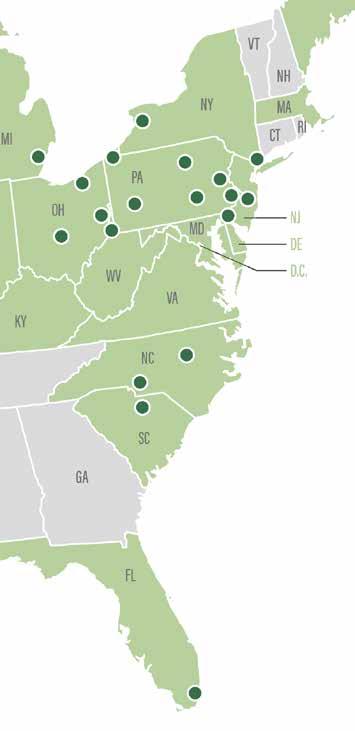
Rooted in Pittsburgh, our client demand expanded the firm’s reach to 19 offices in 10 states. Call us for construction and surety-related questions.

William D. Clifford & W. Alan Torrance, Jr.
Included in The Best Lawyers in America
2023 Commercial Litigation, Construction Law, and Litigation-Construction
University of Pittsburgh selected Massaro Corporation as construction manager for the $1.6 million Frame Westerberg Commons roof-top unit replacement at its Bradford campus.
Massaro Corporation is the general contractor for Pressure Chemical’s new $5 million, 25,000 square foot manufacturing facility in Pittsburgh’s Lawrenceville neighborhood. The new facility was designed by CWWA Engineering.
Carl Walker Construction has been awarded the 2025 maintenance contract for the University of Kentucky’s Kroger Field.
A. Martini & Co. was awarded the new Adult Behavioral Health unit at Latrobe Hospital for Independence Health. This project entails a 23,000 square foot total renovation to the first-floor area as well as a 2,000 square foot outdoor space. IKM Architecture is the architect.
A. Martini & Co. was selected to be the construction manager/general contractor for the new corporate offices for the Pittsburgh Post Gazette on the North Shore. This project includes a complete demolition and rebuilding of 23,000 square feet on the fourth and fifth floors of the building. A Summer start date is planned. LGA Partners is the architect.
Rycon is the general contractor for a new 63,500 square foot three-story science building, which will replace two aging buildings at PennWest California University.
Chase Bank selected Rycon as the general contractor for a new 3,500 square foot branch at Jerome Village in Plain City, OH.
Dick’s Sporting Goods chose Rycon as the general contractor to renovate their existing 110,000 square foot store in Polaris, OH into a House of Sport location.
Two operating rooms are being renovated by Rycon at St. Clair Health Dunlap Family Outpatient Center in Pittsburgh, PA.
Rycon is completing two new food and beverage destinations, Flytes Virtual Dining Hall and Sadella’s Flatbread, at Nashville Internation Airport.
In Madison, TN, Rycon is handling a 7,800 square foot footwear remodel inside a Dick’s Sporting Goods.
Turner Construction was recently awarded Day 2 Work for a confidential client. This scope will consist of the fit-out and finish of previously unmodified areas, as well as security upgrades.
Turner Construction was awarded the next phase of Allegheny Health Network’s Neurology Center of Excellence, which includes all the work associated with the Hemlock Building’s Second Floor West fit out.
C.H. & D. Enterprises, Inc. participated in Cranberry Township’s Community Chest Project of the Year 2024 for the construction of a green gathering space to create a traditional town center for the community. C.H. & D.’s $2.1 million exterior construction package consisted of excavation, 412-281-7272
installation of an underground stormwater detention system, new splash pad, new playground with musical instruments, new pergola, stamped concrete sidewalk, brick pillar construction, renovations to the historic schoolhouse, paving, and landscaping.
Mascaro’s Client Services Group was awarded the contract for the lighting and millwork for the University of Pittsburgh Hillman Library Phase IV Wood Wall.
Mascaro’s Heavy/Industrial Group was awarded the contract for the pre-engineered metal buildings for the Land Wall Equipment and Concrete Testing Buildings at Montgomery Lock and Dam.
Mascaro’s Heavy/Industrial Group will also be completing the concrete pad at the Donora River Terminal as a subcontractor to Goettle.
Under a subcontract to Wayne Crouse, Mascaro’s Heavy/Industrial Group will also be completing the excavation, concrete, steel/metals, and interiors as part of the ALCOSAN Solids Thickening contract.
Point Park University selected Higley Construction to manage the renovations of its Dance Studios at 225 Boulevard of the Allies. The architect for the 8,500 square foot renovation is POH+W Architects.
Moon Area School District awarded a $2.7 million contract for general construction to Caliber Contracting Services for its $4.4 million program of renovations to J.A. Allard Elementary School, J.H. Brooks, Elementary School, Moon Area Middle School, and Moon Area High School. The architect is Axis Architecture.
DiMarco Construction was awarded the general construction contract for the new $8 million Swissvale Borough Building. The architect for the 16,000 square foot new building is Core Architects.
Dick Building Co. was selected as general contractor for the $10 million revitalization of the 1400 Market Block in Wheeling, WV. The project involves restoration of four historic buildings in downtown Wheeling, which will be converted into ground floor commercial and residential use on the upper floors. The architect is Desmone Architects.
TRE CONSTRUCTION

March 27
May 19
June 20
Connect with CREW: Collab with The Business Collective North Shore Developments Panel Discussion
Annual Golf Outing - South Hills Country Club
CREW/NAIOP Pittsburgh Annual Clays Shoot - Highlands Sporting Clays
Check pittsburgh.crewnetwork.org for information on other networking events.
Sponsorship opportunities available.
Please contact Nicole Rebyanski at nrebyanski@chdentinc.com.


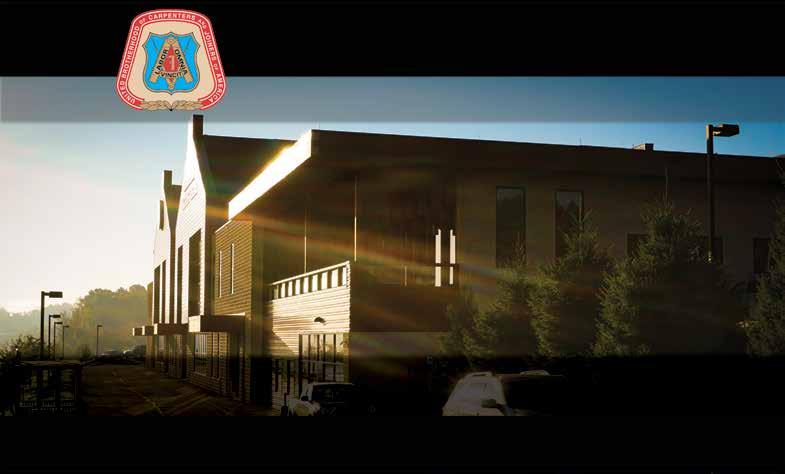

MBA MEMBERSHIP
2025 MBA OFFICERS
President
Michael R. Mascaro
Mascaro Construction Company, LP
Vice President and Treasurer
Alexander G. Dick
Dick Building Company
Secretary/Executive Director
David D. Daquelente
2025 MBA BOARD OF DIRECTORS
John P. Busse
F.J. Busse Company, Inc.
James T. Frantz
TEDCO Construction Corporation
Michael Kuhn
Jendoco Construction Corporation
Jennifer P. Landau
Landau Building Company
Anthony F. Martini
A. Martini & Co.
Steven M. Massaro
Massaro Corporation
David P. Meuschke, P.E.
Burchick Construction Company, Inc.
M. Dean Mosites
Mosites Construction Company
Jake Ploeger
PJ Dick Incorporated
Jodi L. Rennie
Turner Construction Company
John Sabatos
Rycon Construction, Inc.
Raymond A. Volpatt, Jr., P.E., Past President
Volpatt Construction Corporation
Neal Rivers (MICA President)
Easley & Rivers, Inc.
GENERAL CONTRACTORS
AIMS Construction
Allegheny Construction Group, Inc.
Burchick Construction Company, Inc.
Fred L. Burns, Inc.
F.J. Busse Company, Inc.
Caliber Contracting Services, Inc.
CH&D Enterprise, Inc.
Dick Building Company
DiMarco Construction Co., Inc.
E&G Development, Inc.
Elwood Construction Corporation
Facility Support Services, LLC
FMS Construction Company
Gilbane Building Company
Higley Construction
Independence Excavating, Inc.
Jendoco Construction Corporation
Kokosing Industrial Incorporated
Landau Building Company
A. Martini & Co.
Mascaro Construction Company, LP
Massaro Corporation
McCrossin
Menard USA
Mosites Construction Company
Nicholson Construction Company
PJ Dick Incorporated
Rocky Bleier Construction Group
Rycon Construction, Inc.
Shannon Construction Company
Spartan Construction Services, Inc.
Stevens Engineers & Constructors, Inc.
TEDCO Construction Corporation
Turner Construction Company
Uhl Construction Company
Volpatt Construction Corporation
Carl Walker Construction, Inc.
SPECIALTY CONTRACTORS
A Crane Rental, LLC
A. Folino Construction, Inc.
Abate Irwin, Inc.
ABMECH Acquisitions, LLC
ACE Lightning Protection Inc.
Advantage Steel & Construction, LLC
All Crane Rental of Pennsylvania, LLC
Alliance Drywall Interiors, Inc.
Amelie Construction & Supply, LLC
Amthor Steel, Inc.
Brayman Construction Corporation
Bristol Environmental, Inc.
Bruce-Merrilees Electric Co.
Bryan Construction, Inc.
Burke & Company, LLC
dba S.P. McCarl & Company
Burnham Industrial Contractors, Inc.
Buzzelli Group LLC
Centerpoint Painting Systems, LLC.
Century Steel Erectors Co., LP
Clista Electric, Inc.
Cost Company
Costa Contracting, Inc.
Wayne Crouse, Inc.
Cuddy Roofing Company, Inc.
D-M Products, Inc.
Dagostino Electronic Services
Dom DeMarco Construction, Inc.
Donley’s Concrete Group
Douglass Pile Company, Inc.
Easley & Rivers, Inc.
EMCOR Services Scalise Industries
Fay, S&B USA Construction
Ferry Electric Company
First American Industries, Inc.
Flooring Contractors of Pittsburgh
Franco Associates
G. Kidd, Inc.
Gaven Industries, Inc.
Giffin Interior & Fixture, Inc.
Richard Goettle, Inc.
Gregori Construction, Inc.
W.O. Grubb Steel Erection, Inc.
Gumpher, Inc.
Gunning, Inc.
Geo. V. Hamilton, Inc.
Hanlon Electric Company
Harris Masonry, Inc.
Hatzel & Buehler, Inc.
HOFF Enterprises, Inc.
Howard Concrete Pumping, Inc.
Hunt Valley Environmental, LLC
JLJI Enterprises, Inc.
Kalkreuth Roofing & Sheet Metal, Inc.
KELLER North America
Keystone Electrical Systems, Inc.
Kirby Electric, Inc.
Kusler Masonry, Inc.
L & E Concrete Pumping Inc.
Lanco Electric, Inc.
Lighthouse Electric Company, Inc.
Limbach Company, LLC
Lisanti Painting Company
Marsa, Inc.
Massaro Industries, Inc.
Master Woodcraft Corporation
Matcon Diamond, Inc.
Maxim Crane Works, LP
McCrossin Foundations, LLC
McKamish, Inc.
Mele & Mele & Sons, Inc.
Mohawk Construction & Supply, Inc.
J.J. Morris & Sons, Inc.
NAES Power Contractors
Next 150 Construction, LLC
Noralco Corporation
Paramount Flooring Associates, Inc.
T.D. Patrinos Painting & Contracting Company
Phoenix Roofing, Inc.
Pittsburgh Interior Systems, Inc.
Precision Environmental Company
RAM Acoustical Corporation
Redstone Flooring, LLC
Renick Brothers Construction Co.
Right Electric, Inc.
Ruthrauff | Sauer, LLC
Saint’s Painting Company, Inc.
Sargent Electric Company
Schindler Elevator
Schlaegle Design Build Associates, Inc.
Schnabel Foundation Company
Specified Systems, Inc.
Spectrum Environmental, Inc.
SSM Industries, Inc.
Swank Construction Company, LLC
W.G. Tomko, Inc.
TRE Construction
Tri-State Flooring, Inc.
A. J. Vater & Company, Inc.
Worldwide Services, LLC
Wright Commercial Floors
Wyatt, Incorporated
AFFILIATE
MEMBERS
4CTechnologies
84 Lumber
ADMAR Construction Equipment and Supply
ADP
Aeropol LLC
AEC Online Store LLC
African American Chamber of Commerce of
Western PA
Allegheny County Airport Authority–
Pittsburgh International Airport
Alliant
American Contractors Insurance Group
American Producers Supply Company
Amerisafe Group
AmeriServ Trust and Financial Services Company
Aon
Assured Partners of PA, LLC
Atlantic Engineering Services
Atlas Marketing
Atlas Wholesale Co., Inc.
AUROS Group
Babst | Calland
Baker Tilly Virchow Krause, LLP
Michael Baker International
BDO USA, LLP
Beemac Inc.
Beth-Hanover Supply Co., Inc.
Black Diamond Equipment Rental
Bowles Rice
R.J. Bridges Corporation
Bronder & Company, P.C.
Tom Brown, Inc.
Building Point Ohio Valley
Burns Scalo Real Estate Services, Inc.
Burns White, LLC
Cadnetics, Inc.
Case|Sabatini
CENTRIA
A.R. Chambers & Son, Inc.
Chartwell Investment Partners
Chubb Group of Insurance Companies
Civil & Environmental Consultants, Inc.
Clark Hill PLC
Cleveland Brothers Equipment Co., Inc.
CliftonLarsonAllen LLP
Cohen, Seglias, Pallas, Greenhall & Furman PC
Computer Fellows, Inc.
Cozen O’Connor
CTR Payroll & HR
Dentons Cohen & Grigsby P.C.
DesignGroup
Desmone Architects
Dickie, McCamey & Chilcote, P.C.
Dingess, Foster, Luciana, Davidson & Chleboski, LLP
Ditto
Dollar Bank
DRAW Collective Architecture
Eckert Seamans Cherin & Mellott
ECS Mid Atlantic, LLC
EPIC Insurance Brokers & Consultants
FASTSIGNS of Pittsburgh
Fahringer, McCarty, Grey, Inc.
FDR Safety, LLC
FieldForce Equipment Sales & Rentals, LLC
First National Insurance Agency
Fisher Phillips
Frost Brown Todd, LLC
Gallaway Safety & Supply
The Gateway Engineers, Inc.
GM Equipment Rentals
Graystone Consulting Pittsburgh Cleveland
Green Dot Active Solutions, Inc.
A.L. Harding & Company
H2R CPA
J. S. Held
Henderson Brothers, Inc.
HHSDR Architects/Engineers
Highway Equipment Company
Hillis Carnes Engineering Associates, Inc.
Huth Technologies LLC
Intertek - PSI
IMA Corp
JLL
Karpinski Engineering
K&L Gates LLP
L & W Supply
LaFace & McGovern Associates, Inc.
Langan Engineering & Environmental Services
Liberty Insurance Agency
Liberty Mutual Surety
Lytle EAP Partners/Lytle Testing Services, Inc.
Maiello, Brungo & Maiello
Marthinsen & Salvitti Insurance Group
McKim & Creed, Inc.
McNees Wallace & Nurick, LLC
Meyer Unkovic & Scott, LLP
Meyers Company
Michael Brothers Companies
Milwaukee Tool
Mobile Air, Inc.
Mobile Medical Corporation
Morgan, Lewis & Bockius LLP
MSA Safety
MSW Supply
Multivista
NCI - Nursing Corps
New Millennium Building Systems
NextEra Energy
Ohio Valley Drywall Supply
OVD Insurance
PenTrust
Philadelphia Insurance Companies
Pietragallo Gordon Alfano Bosick & Raspanti, LLP
Pittsburgh Mobile Concrete, Inc.
Reed Building
Repco II
Republic Services, Inc.
Henry Rossi & Co., LLP
Schneider Downs & Company, Inc.
Scotti Law Group
Seubert & Associates, Inc.
The Sherwin-Williams Co.
Sprague Energy
Stanley Black & Decker Stephany Associates, Inc.
Steptoe & Johnson PLLC
Suburban Propane
Sunbelt Rentals, Inc.
Tarax Service Systems, Inc.
Travelers Bond & Financial Products
Triangle Fastener Corporation
Triumph Modular
Tucker Arensberg, P.C.
UBS Financial Services / The Sofranko Group
Unified Door & Hardware
United Rentals, Inc.
UPMC Work Partners
USI Insurance Services
Werner Co
White Cap
Willscot Mobile Mini
WTW – Willis of Pennsylvania, Inc.
WNA Engineering, Inc.
Zurich NA Construction
EquipmentShare
FACES & NEW PLACES
Independence Excavating Inc. welcomed Ben Jacobs as business development manager.
Ryan Eckels, Nate Schachner and Matt Solina joined Independence Excavating as project engineers.
Menard North America announced that Seth Pearlman has been appointed chairman of Menard North America, and Hubert Scache, who has served as president of Menard Canada for the past six years, has been promoted to CEO effective January 1, 2025. Pearlman, who has led Menard’s North American operations for over two decades, will continue to provide strategic oversight in his new role as chairman.
Mosites Construction announced that Caleb Buttermore joined the company as estimator, Building Division. Caleb has five years of experience in the construction industry. He is finishing his master’s degree in business administration at Robert Morris University and served in the United States Marine Corps from 2015 to 2019.
Nick Bandi joined Mosites Construction as payroll/ accounting associate. Nick is a 2024 graduate from the University of Pittsburgh with a Bachelor of Science in Business Administration and Finance, and a minor in Economics.
Jendoco Construction Corporation welcomed Bob Kacin as project manager. Kacin has 12 years of field experience, previously working for a global construction manager as superintendent, project engineer, and assistant project manager.
Adam Mandella returned to Turner Construction Pittsburgh as shop foreman. He will provide support to Turner job sites through its warehouse operations.
On January 13, Tom Crawford joined Mascaro as a senior project manager. He has a degree in Construction Engineering Technology from the University of Toledo and has almost 20 years of experience in the heavy industrial market.
Josh Reynolds joined Mascaro on January 13 as a project engineer at ALCOSAN. He graduated from the University of Pittsburgh at Johnstown with a civil engineering degree.
With over 25 years of construction experience, Jamie Sawich joined Mascaro as an estimator in its Heavy/Industrial Group on February 10. He is an Ironworker and has been a part of Ironworkers Local #3 since 2000. Prior to joining Mascaro, Jamie served as a superintendent for 14 years focusing on various structural steel and bridge rehabilitation projects across PA, WV, and OH, while also assisting with estimating.
Jakob Seman joined Mascaro as a project engineer on February 10. Prior to joining Mascaro, he was a union laborer for five years working on a variety of projects including residential, commercial, industrial, and heavy civil jobs. He is currently working towards a B.S. in Construction Management online through Louisiana State University.
Mike Penrod was promoted to senior vice president, risk management and labor operations at Rycon Construction. Penrod is a graduate of Indiana University of Pennsylvania with a B.S. in Safety Management. He joined Rycon as safety director in January 2007.
Rycon Pittsburgh is excited to welcome Clarion University alumna, Sue Davis, as an estimating coordinator.
Rycon Pittsburgh is pleased to welcome Amy FerchakPetrie as a project coordinator, with over 27 years’ experience.
Brenda Salcedo, an alumna of The Catholic University of America, has joined Rycon Pittsburgh as lead estimator.
Gustavo Lopez joined Craftworks USA as an engineer.
CLOSING OUT
MAINTAINING RELIABILITY DURING THE ENERGY TRANSITION IS VITAL
By Tim Gallagher, President & CEO, ReliabilityFirst Corporation
Energy fuels our economy, is essential to our safety and welfare, and empowers us to achieve our environmental goals. Our nation is undergoing a significant energy transition, shifting away from dispatchable fossil fuel power plants toward renewable energy sources to power our electric grid. This transition coincides with a rapidly increasing demand for electricity. We must carefully manage this change while balancing the “energy trilemma,” the delicate interplay between the reliability of electricity, its affordability for customers, and the environmental sustainability of producing and supplying it. Every modification to the grid presents a trade-off. Improving one aspect of this trilemma may negatively impact another. For example, retiring a power plant due to environmental policy may compromise grid reliability if this is done without ensuring that adequate replacement resources are in place. That’s why all changes must be meticulously planned and coordinated, a process that must also consider the strength of our energy supply chains.
The demand for electricity is surging at rates two to three times higher than it has in previous decades. This surge is being driven by increased electrification of homes, buildings, and transportation, coupled with the growth of energy-intensive industries like data centers, cryptocurrency mining, hydrogen production, and the reshoring of key manufacturing. Meeting these growing energy demands is crucial for our economic prosperity, health, safety, and national security.
However, our electricity supply is not keeping pace with this rising demand; in fact, it is decreasing, potentially leading to future shortfalls. Existing dispatchable power plants, which offer the ability to be adjusted on demand by grid operators to match supply with electricity demand, are in many cases being retired before suitable and sufficient replacements are in place. Planned replacements are predominantly solar resources, and due to their intermittent/weather-dependent nature, require significantly more capacity to produce the same amount of energy as the dispatchable fossil fuel-based sources they are replacing.
Maintaining a perfect balance between electricity supply and demand at all times is critical, but this alone does not guarantee reliability. Dispatchable generators provide what we call in our industry “essential reliability services” that renewable resources cannot currently replicate. This is due to the fundamental difference between generating electricity with a spinning turbine versus microprocessor-based technology. These essential services must be provided to keep the electric system performing properly and to prevent small disturbances from leading
to widespread blackouts. A diverse mix of energy sources that include essential reliability services can best ensure reliability. We must effectively integrate clean renewable energy sources into the power grid, but we must also acknowledge their current limitations. While renewables hold great promise, a solely renewable system currently faces challenges in consistently meeting energy demands.
Energy storage offers a compelling solution. Batteries and other forms of this technology are crucial for addressing the intermittency of renewable energy sources and bolstering grid reliability. Solar and wind power fluctuate depending on weather conditions and time of day, creating challenges for grid operators. Batteries can store excess energy generated during periods of high production and discharge it when needed, effectively smoothing out these fluctuations. However, it is important to note that while batteries can unlock some of the value of renewables by managing their intermittency, they require charging and can sometimes represent a load on the grid rather than a source of supply. While batteries are vital for integrating renewables, and their technology has advanced, further scaling up the deployment of affordable energy storage is still needed to ensure grid reliability.
Given the complexities of the energy trilemma, and the limitations of current technologies, policymakers must be strategic in weighing reliability, cost, and environmental impact when shaping our energy future. A balanced and collaborative approach will align policy implementation with the timing of resource retirements and additions, technology development and scaling, and the establishment of robust supply chains. Policies that decrease supply while projected demand is surging warrant careful reevaluation. By thoughtfully planning and collaborating on strategic decisions, the interconnected challenges of the energy trilemma can be effectively addressed. The expectations we all have for a reliable electricity supply depend on it.

Tim Gallagher is president and CEO of ReliabilityFirst, one of six regional organizations responsible for ensuring the reliability and security of the North American Bulk Electric System. Under the authority of the federal government, the organization monitors and enforces reliability standards for almost 300 utilities across 13 states and Washington, D.C.
Tim Gallagher









